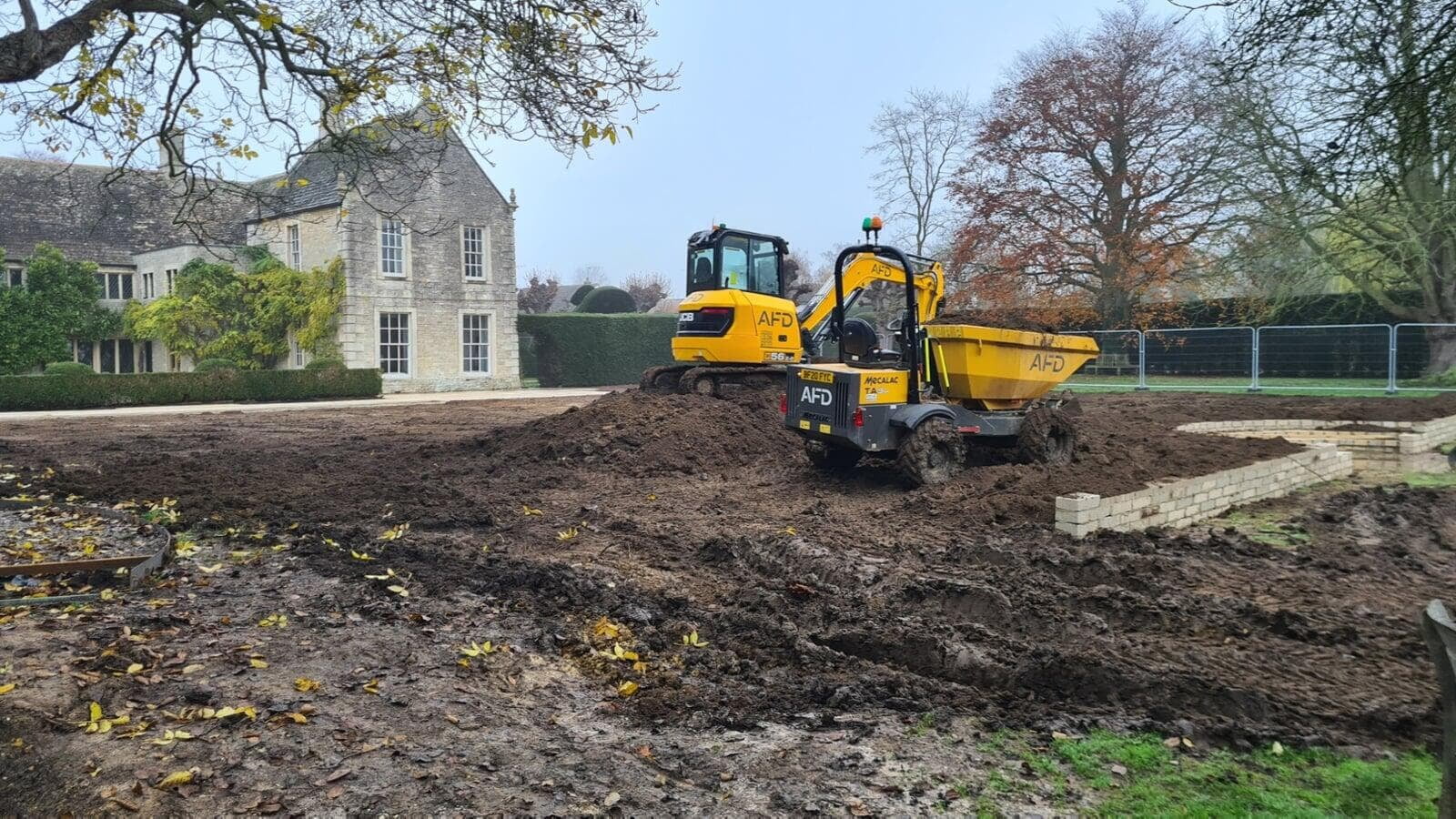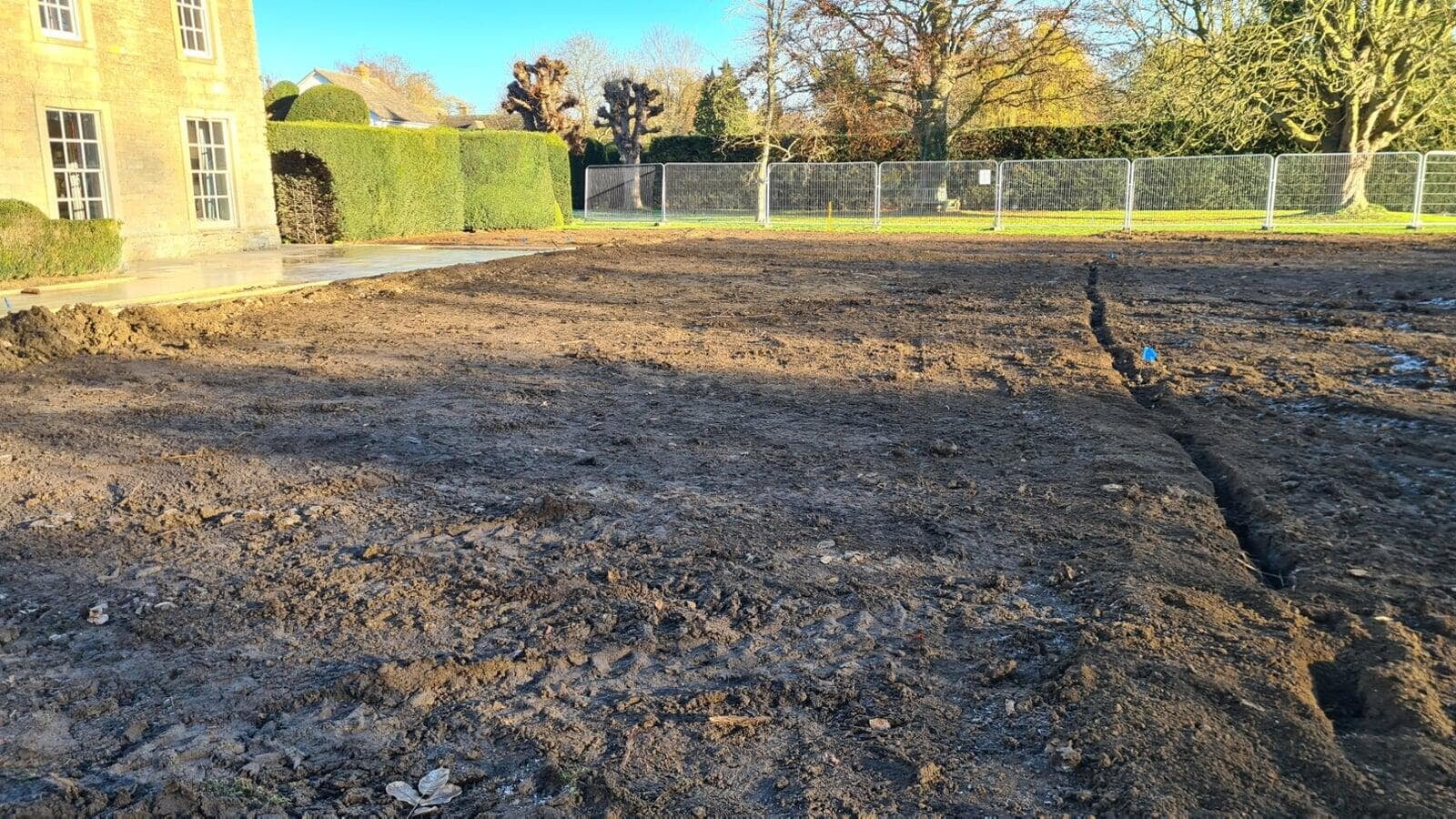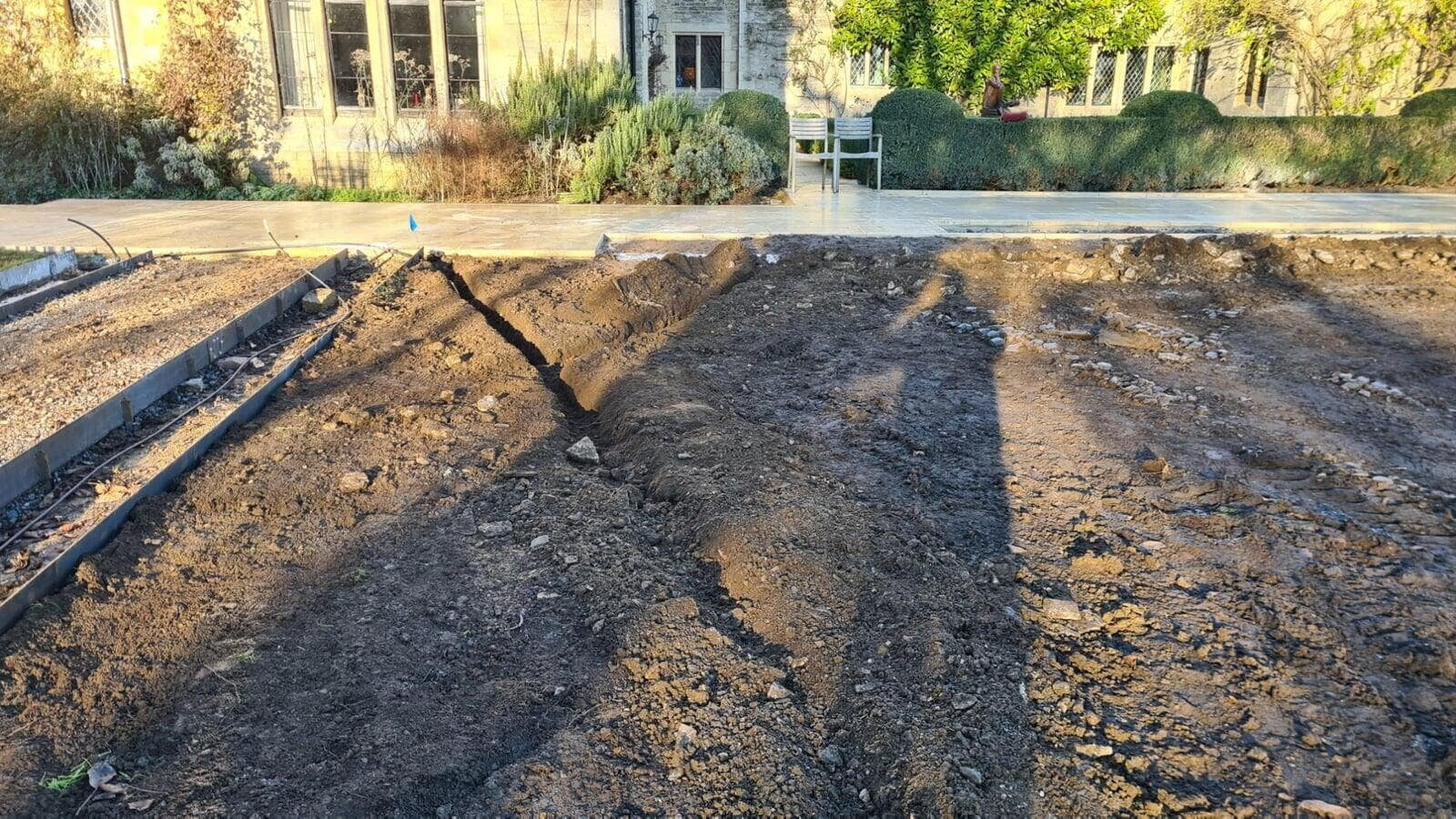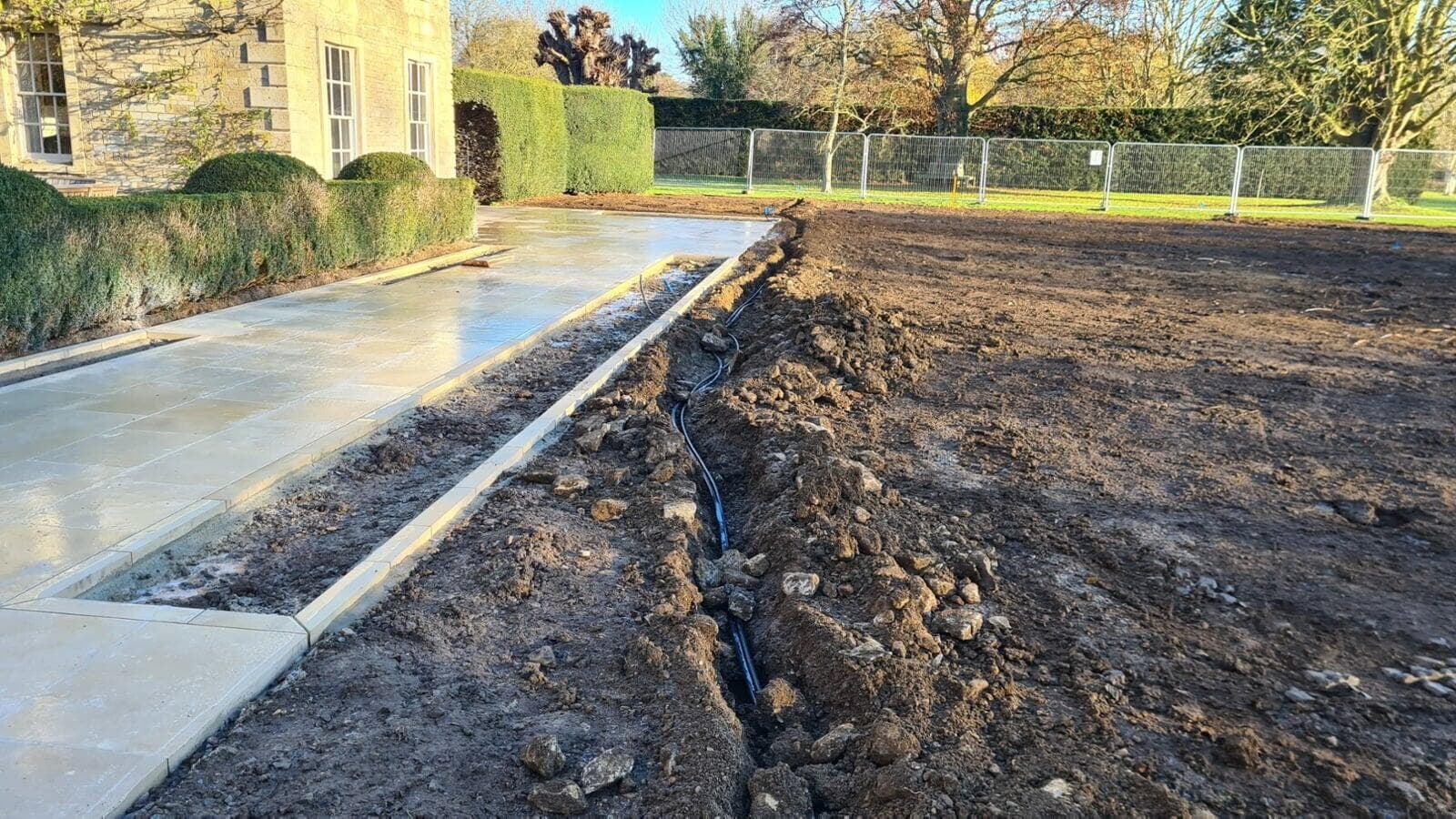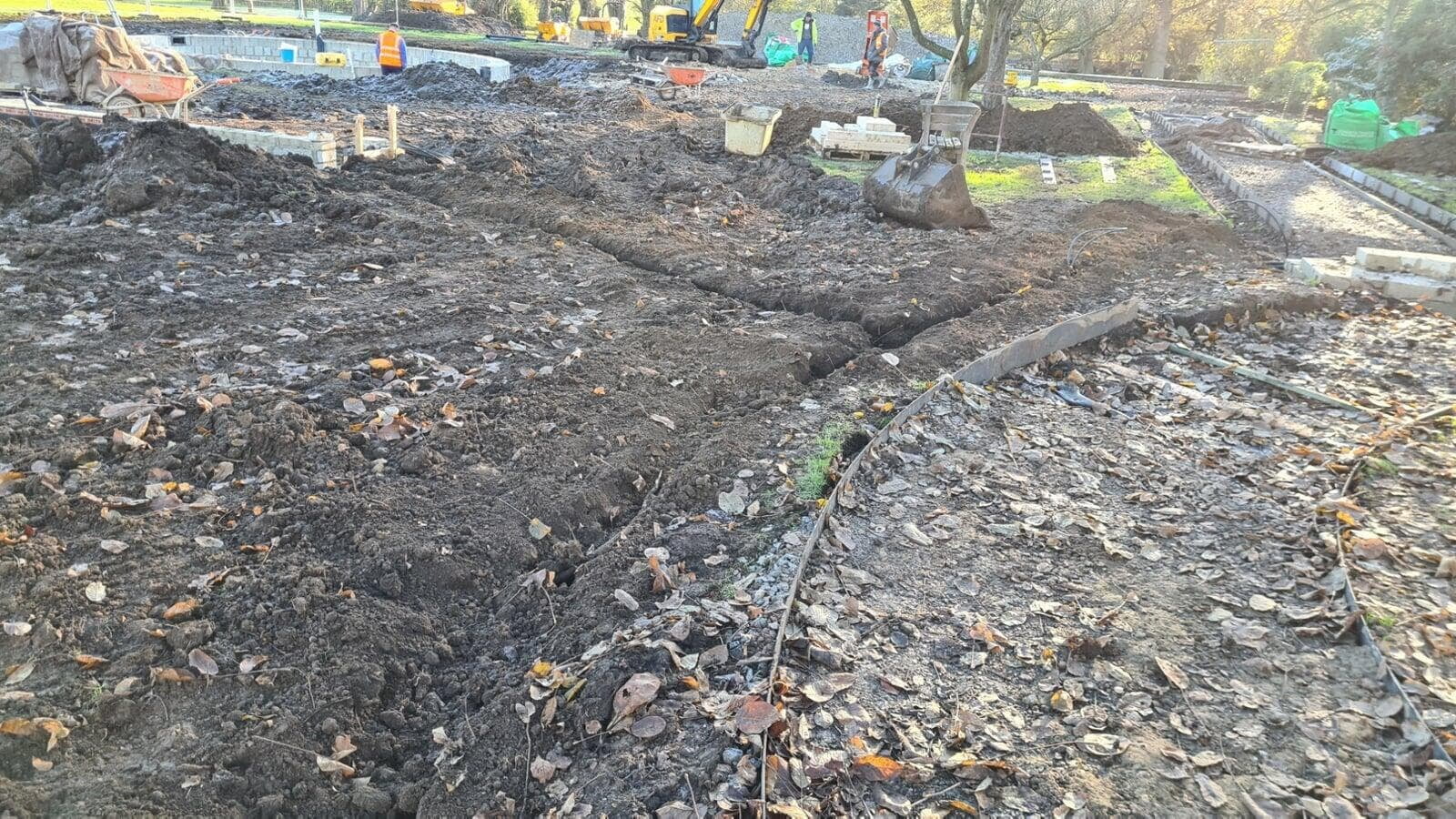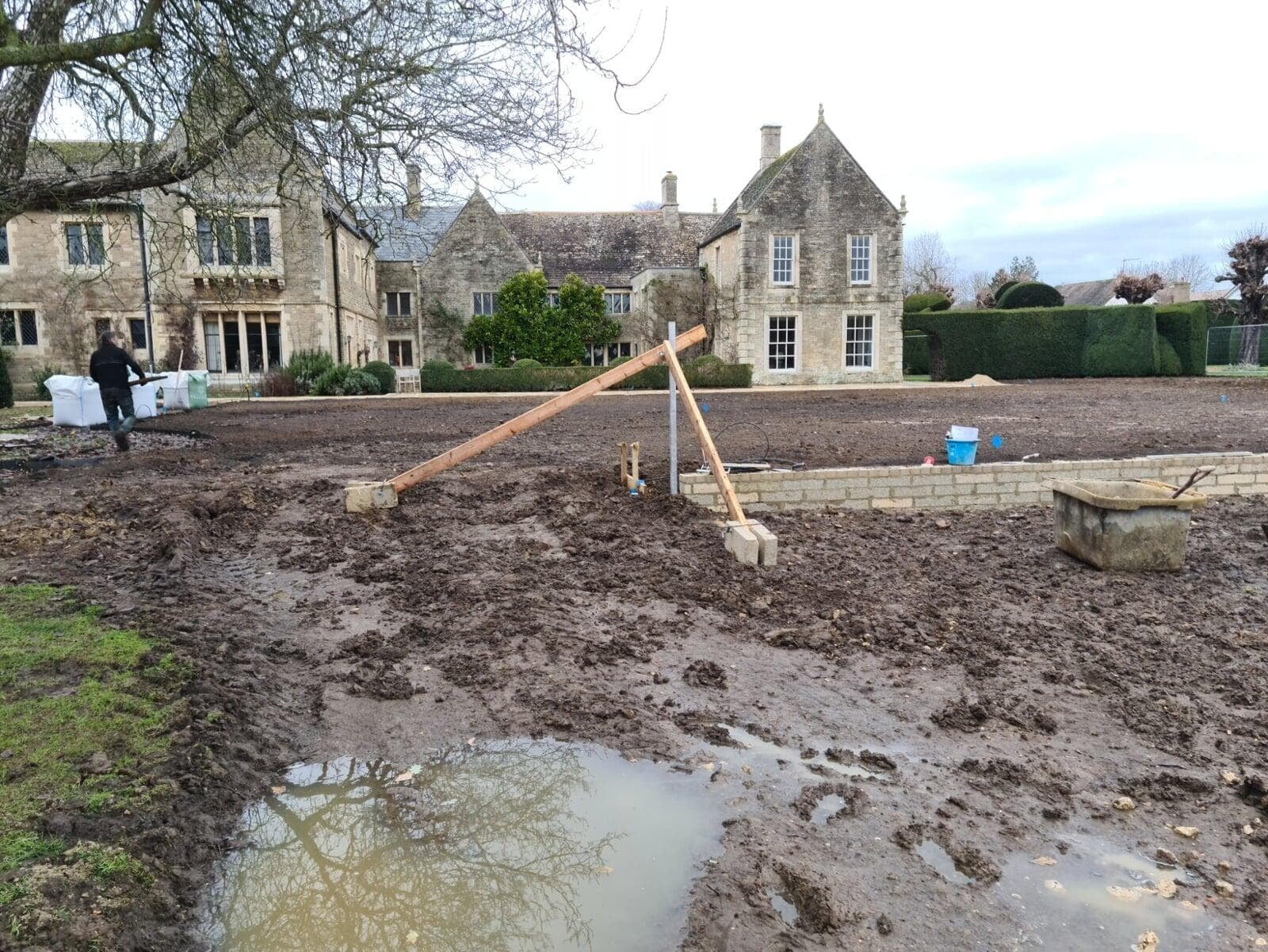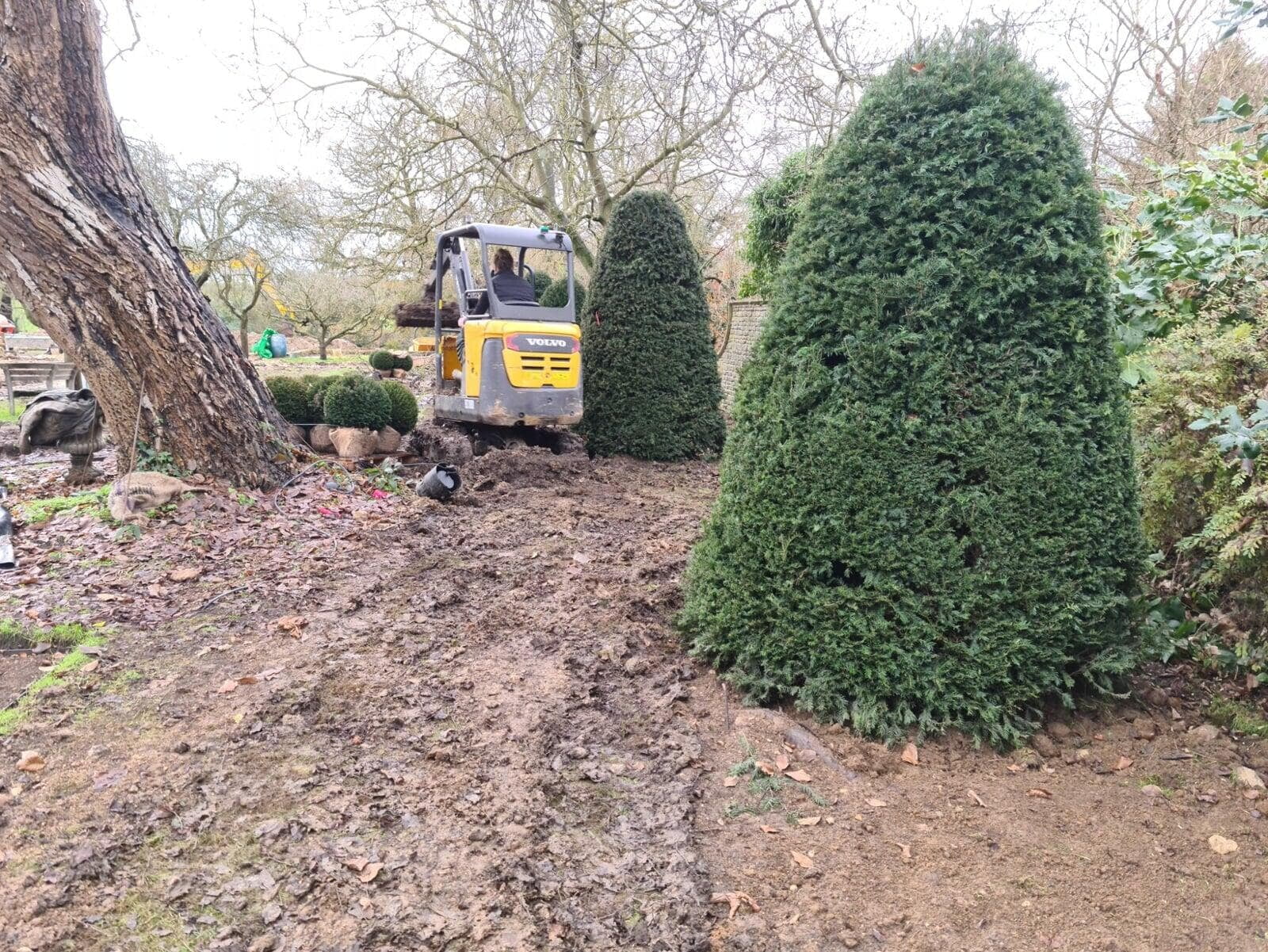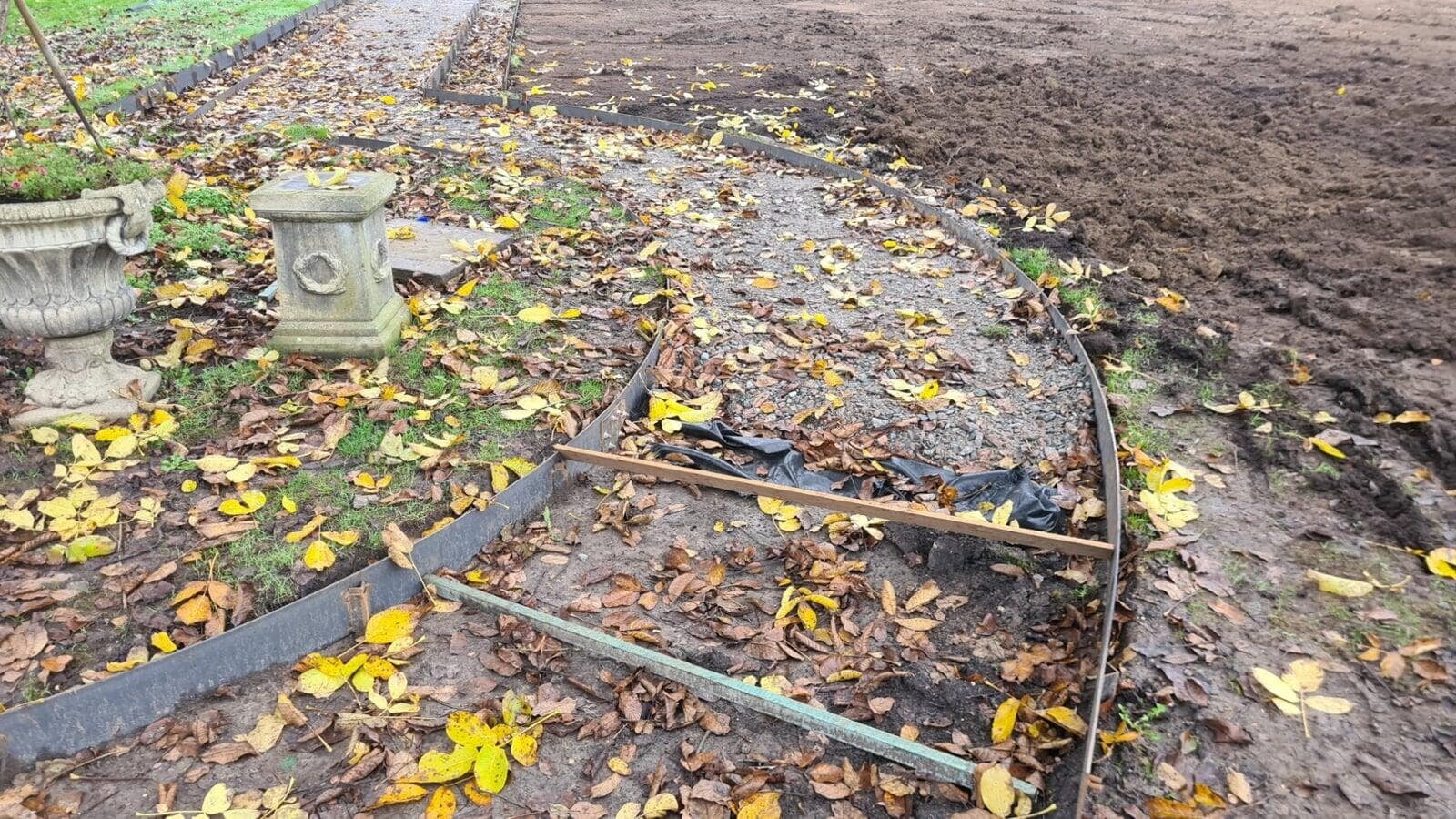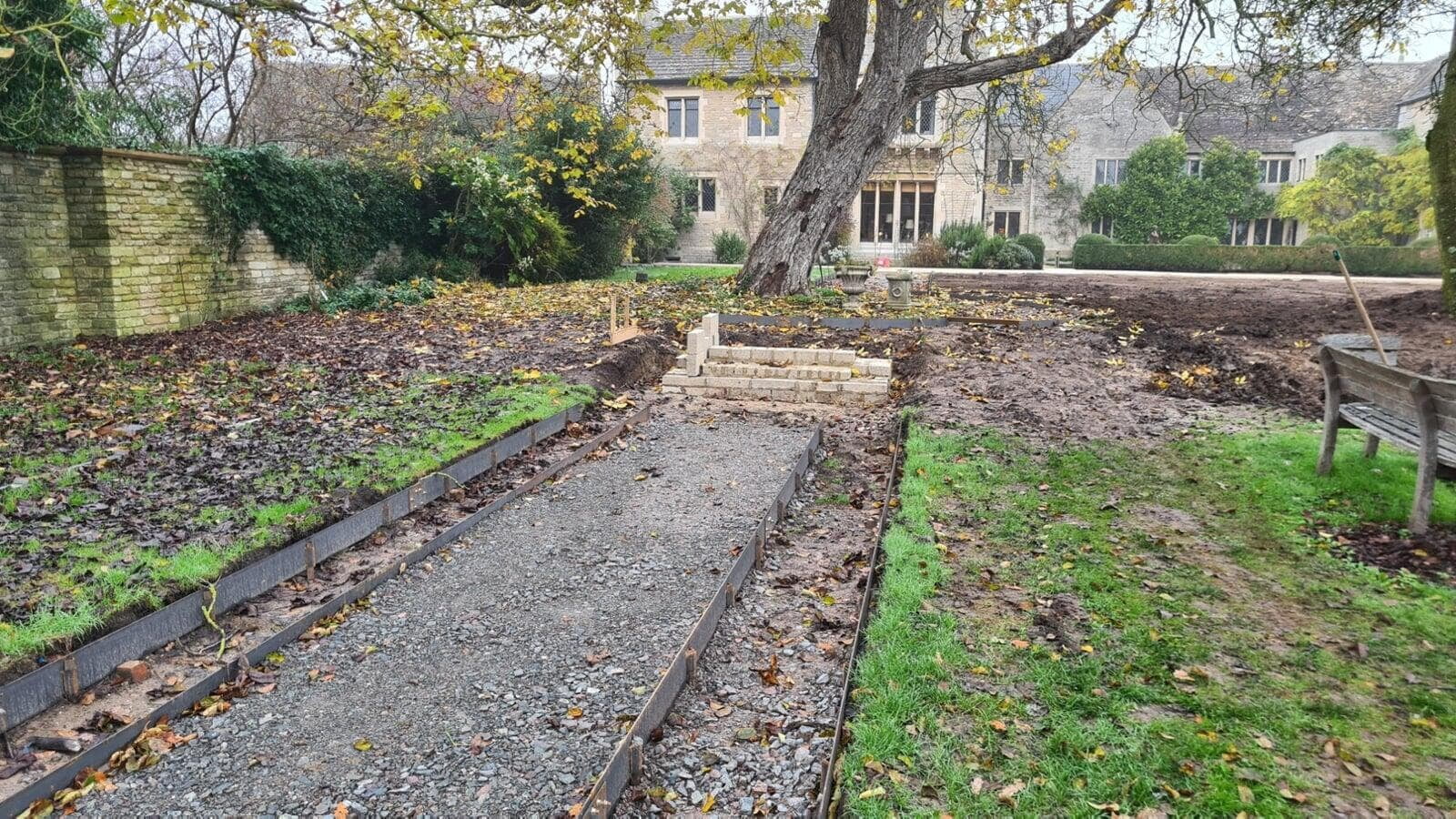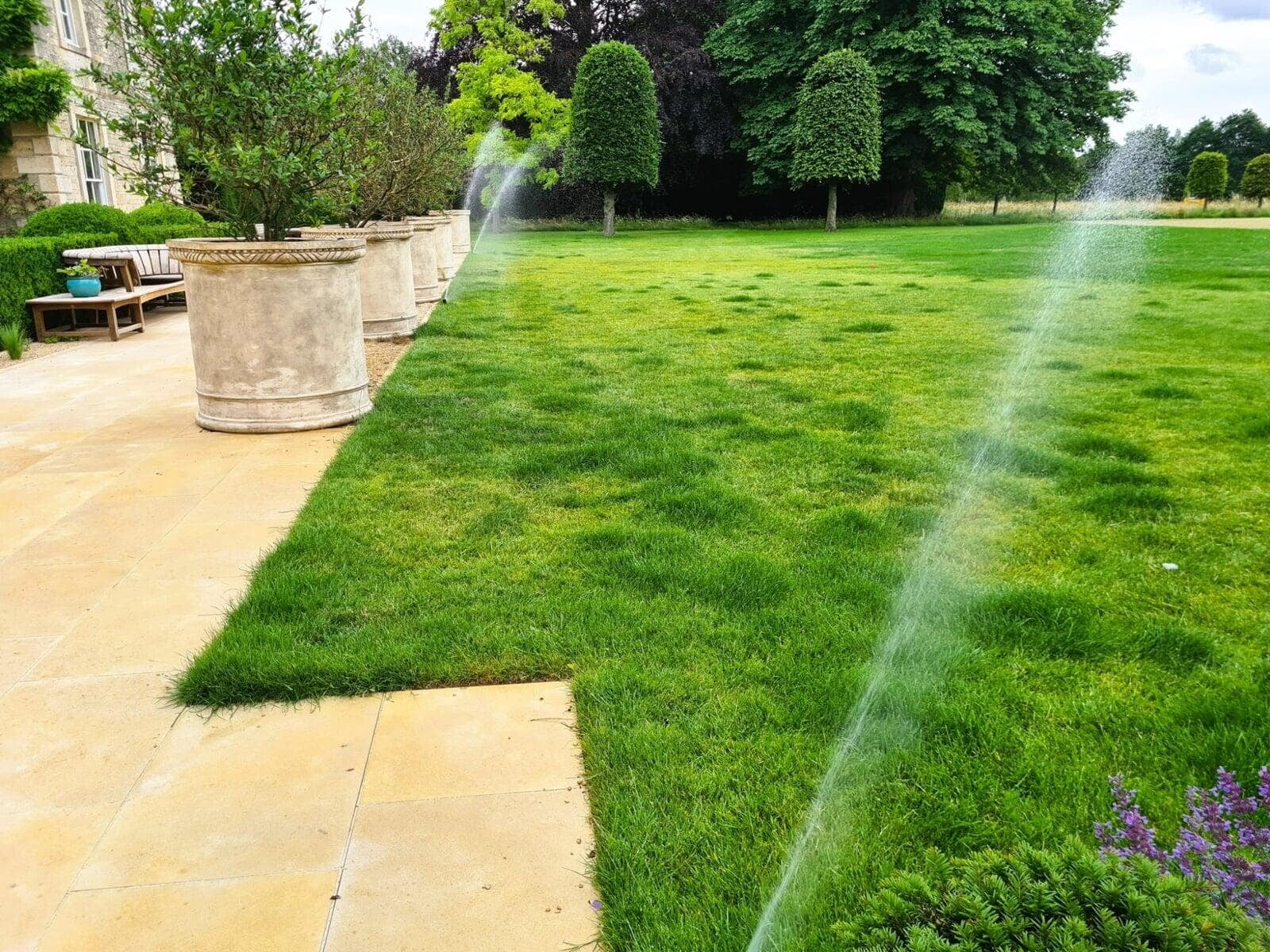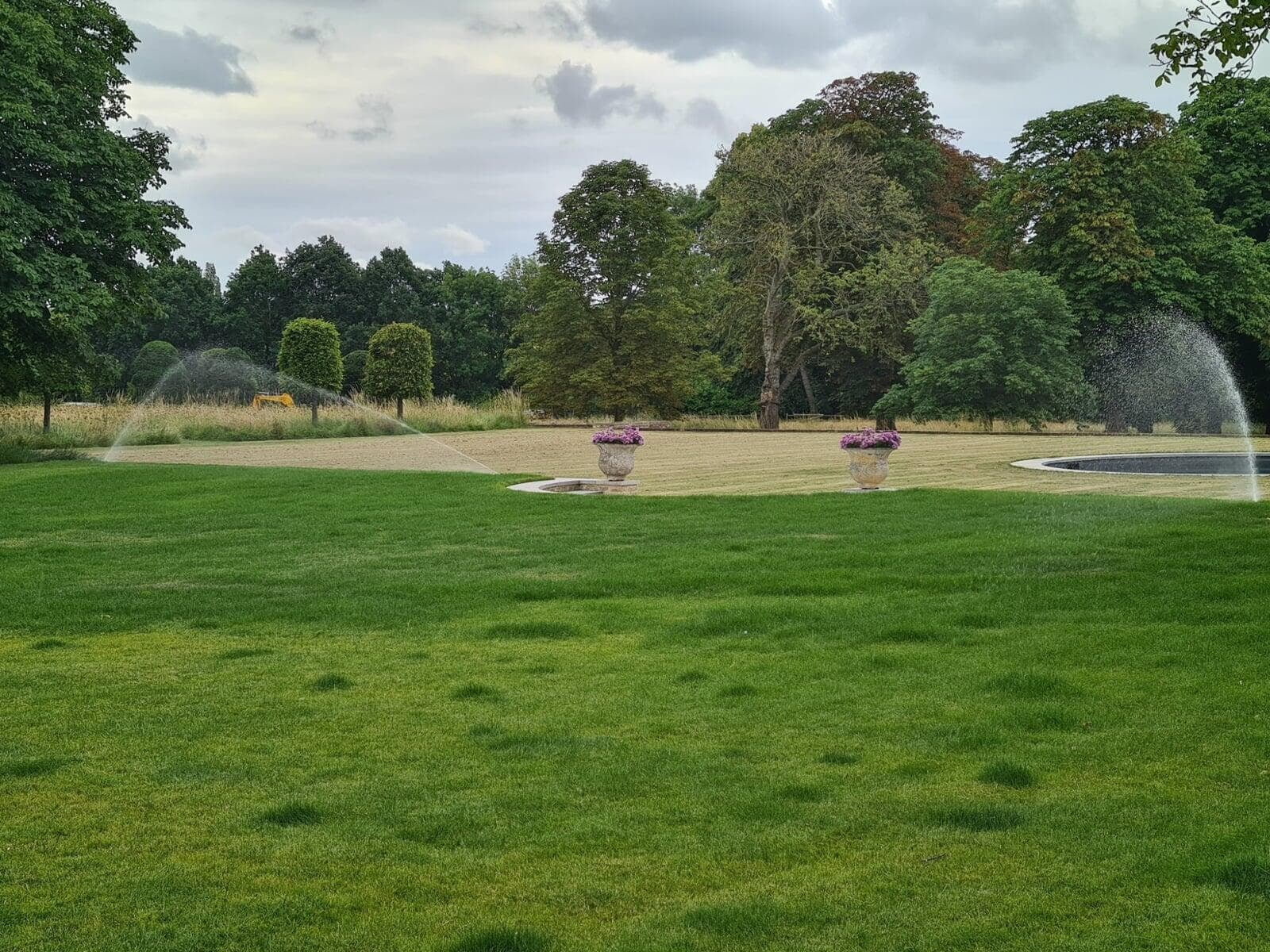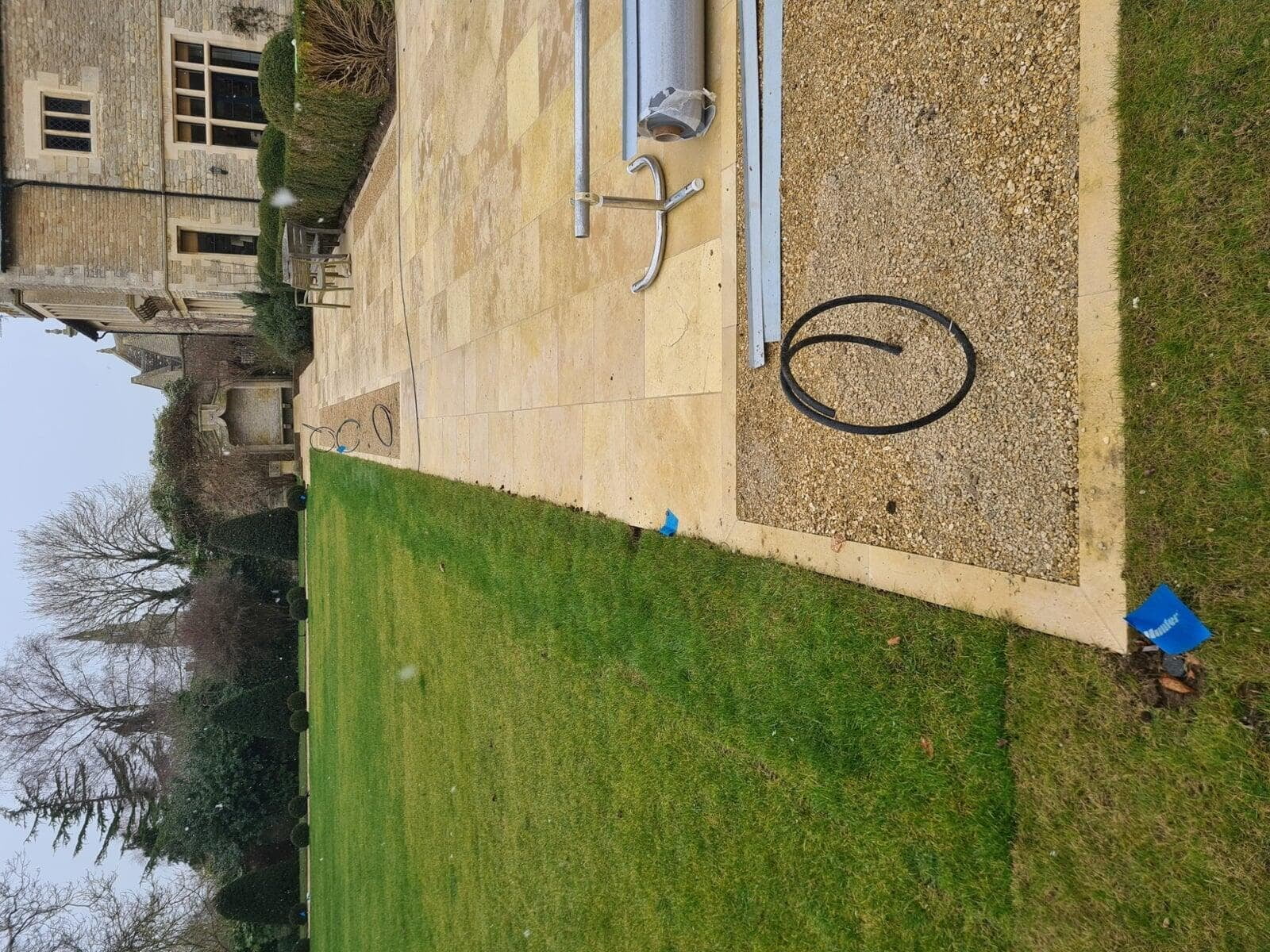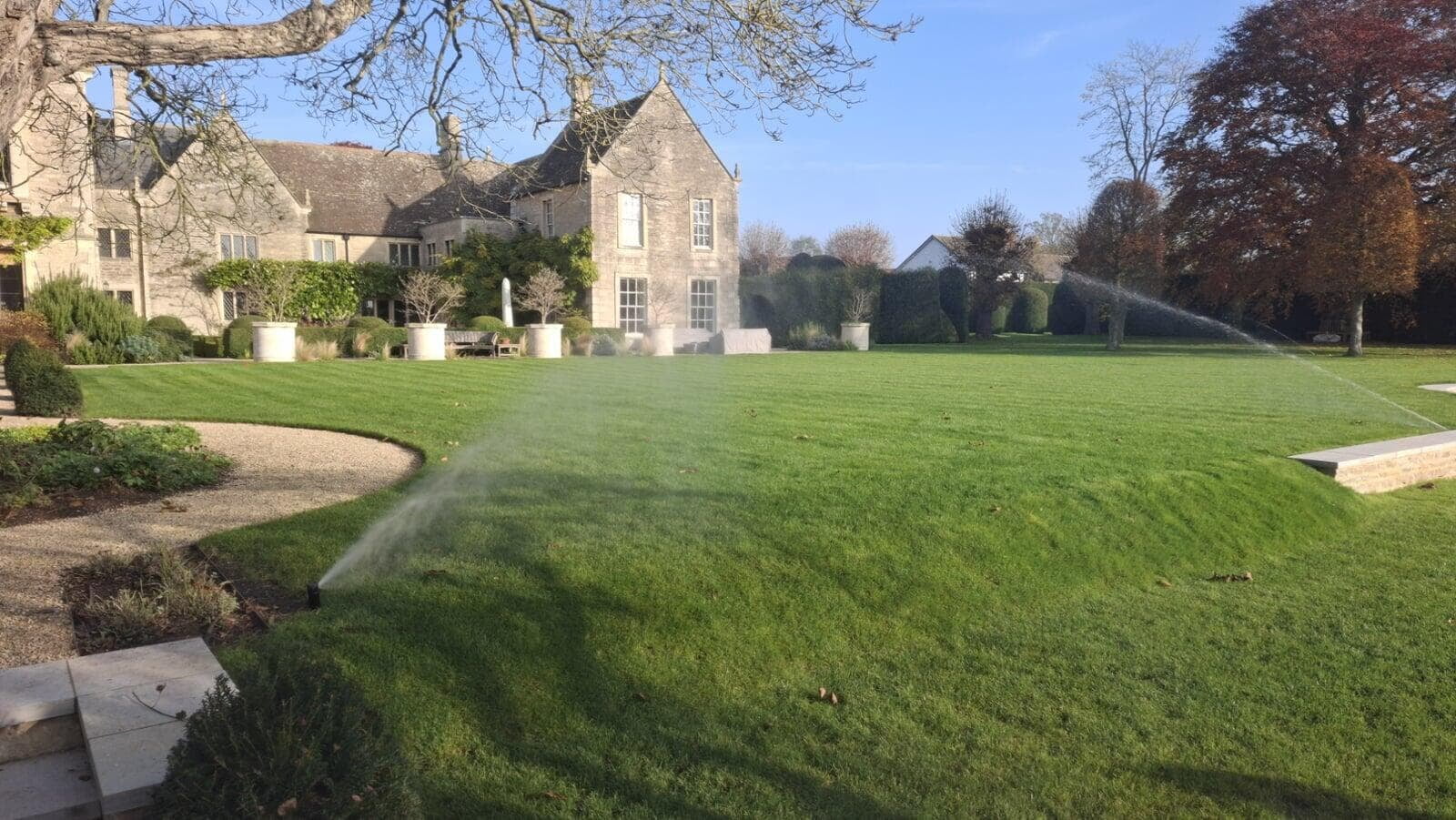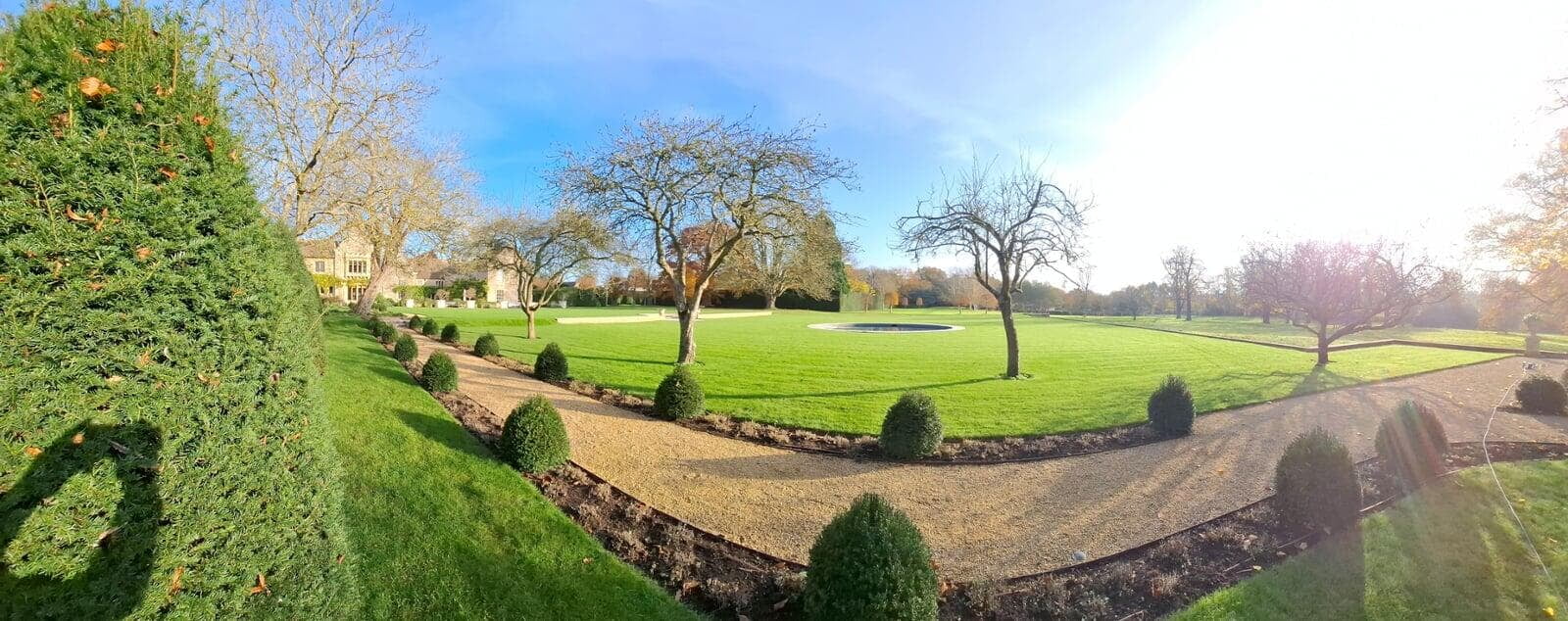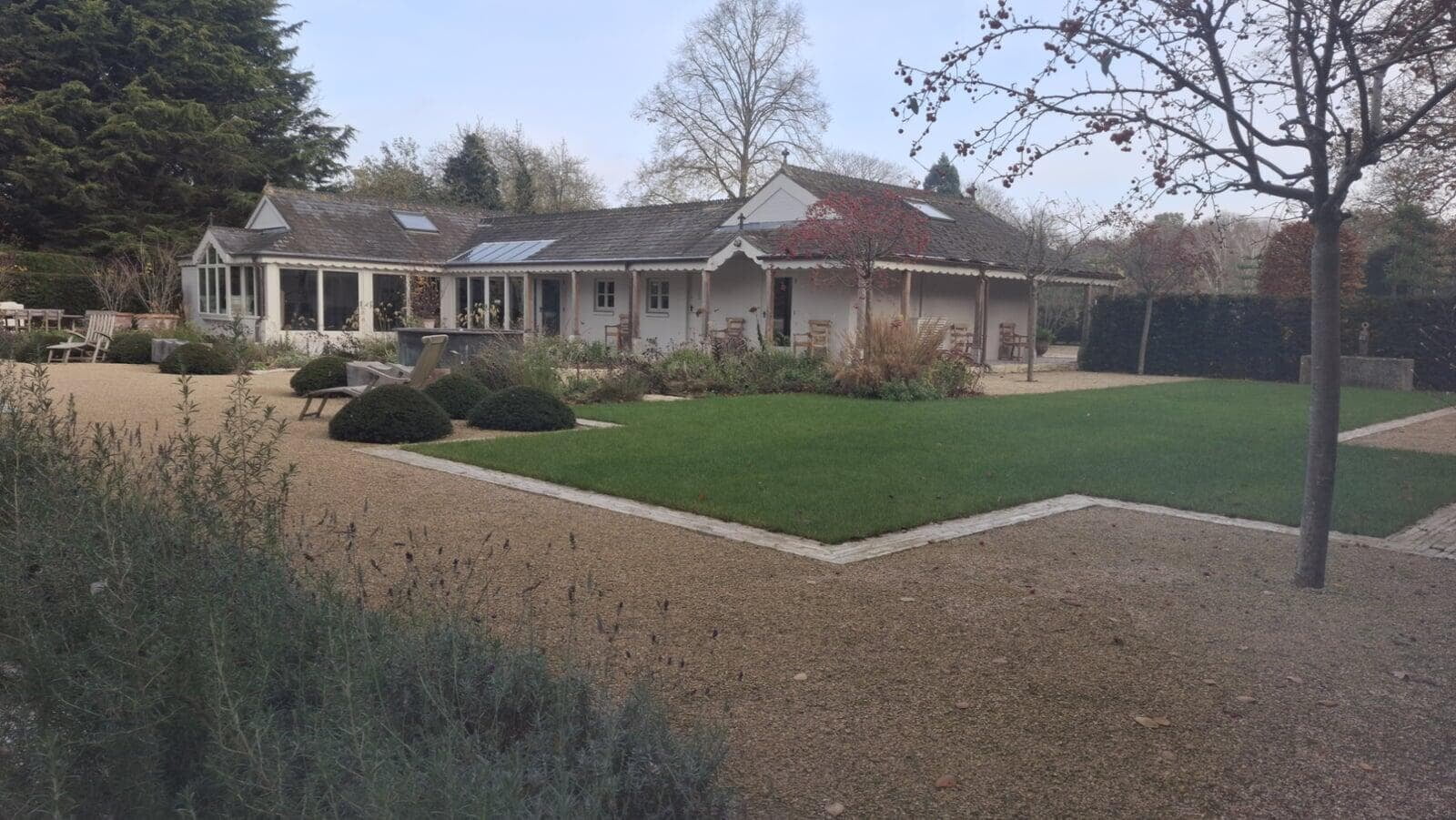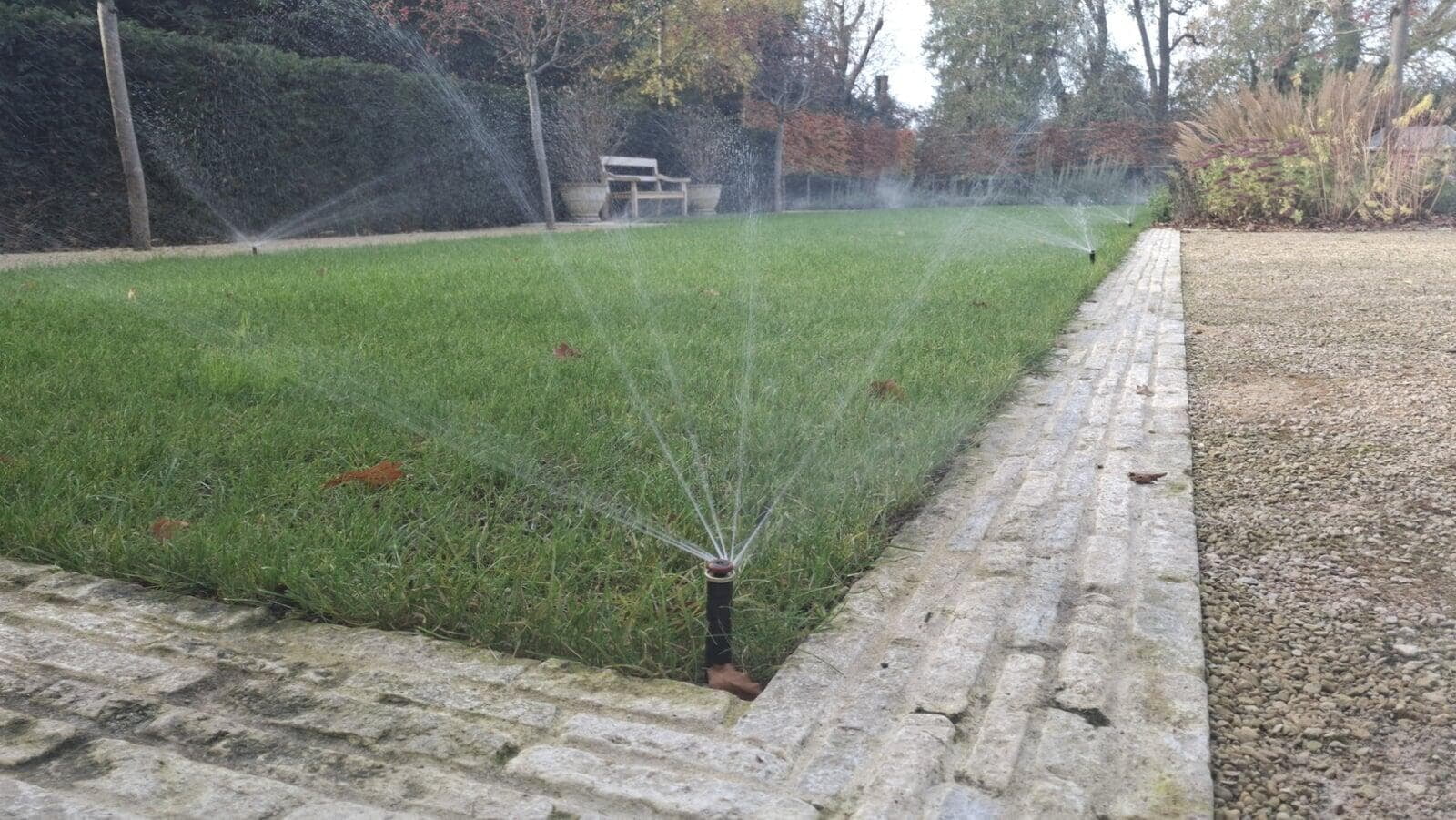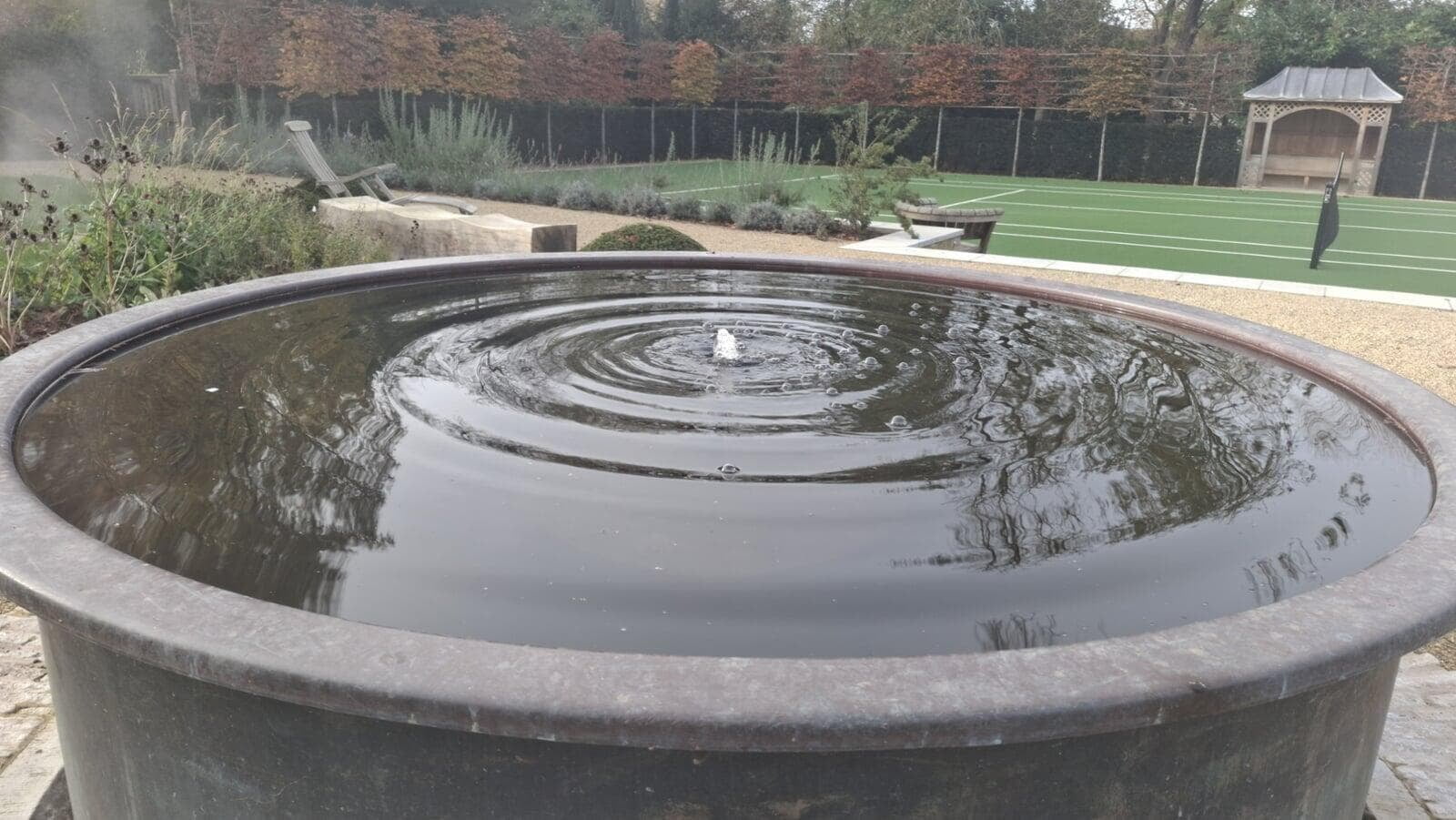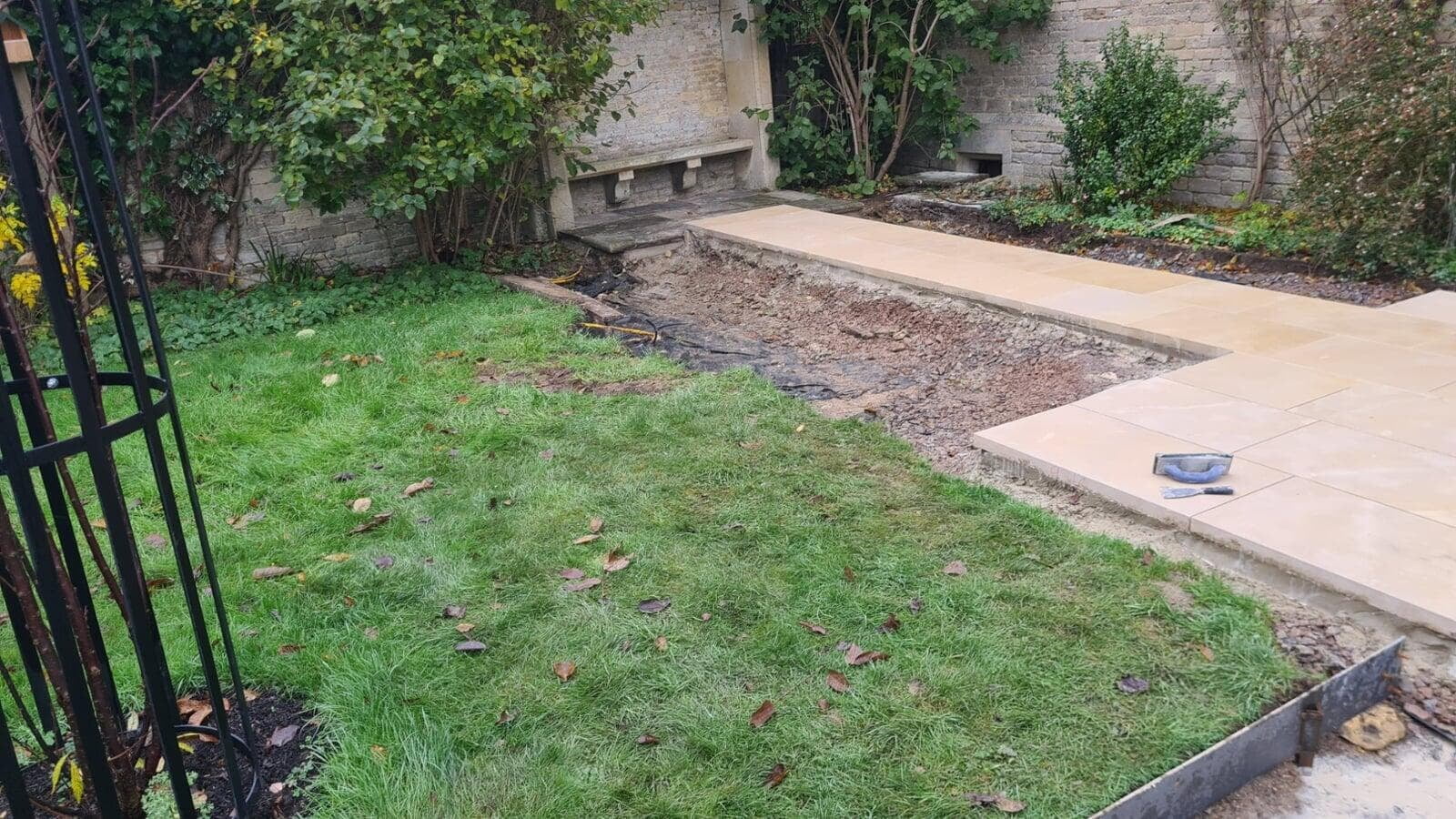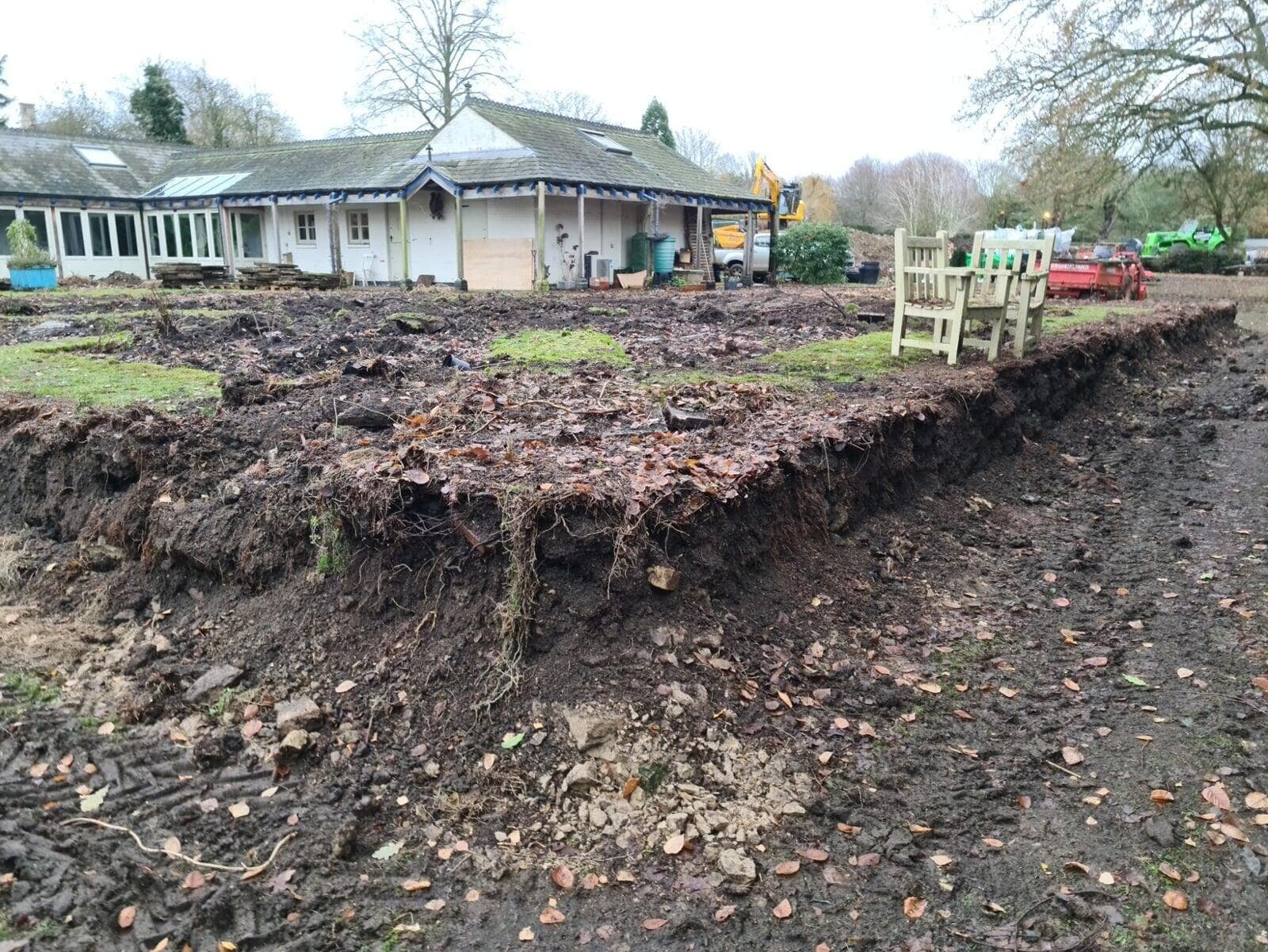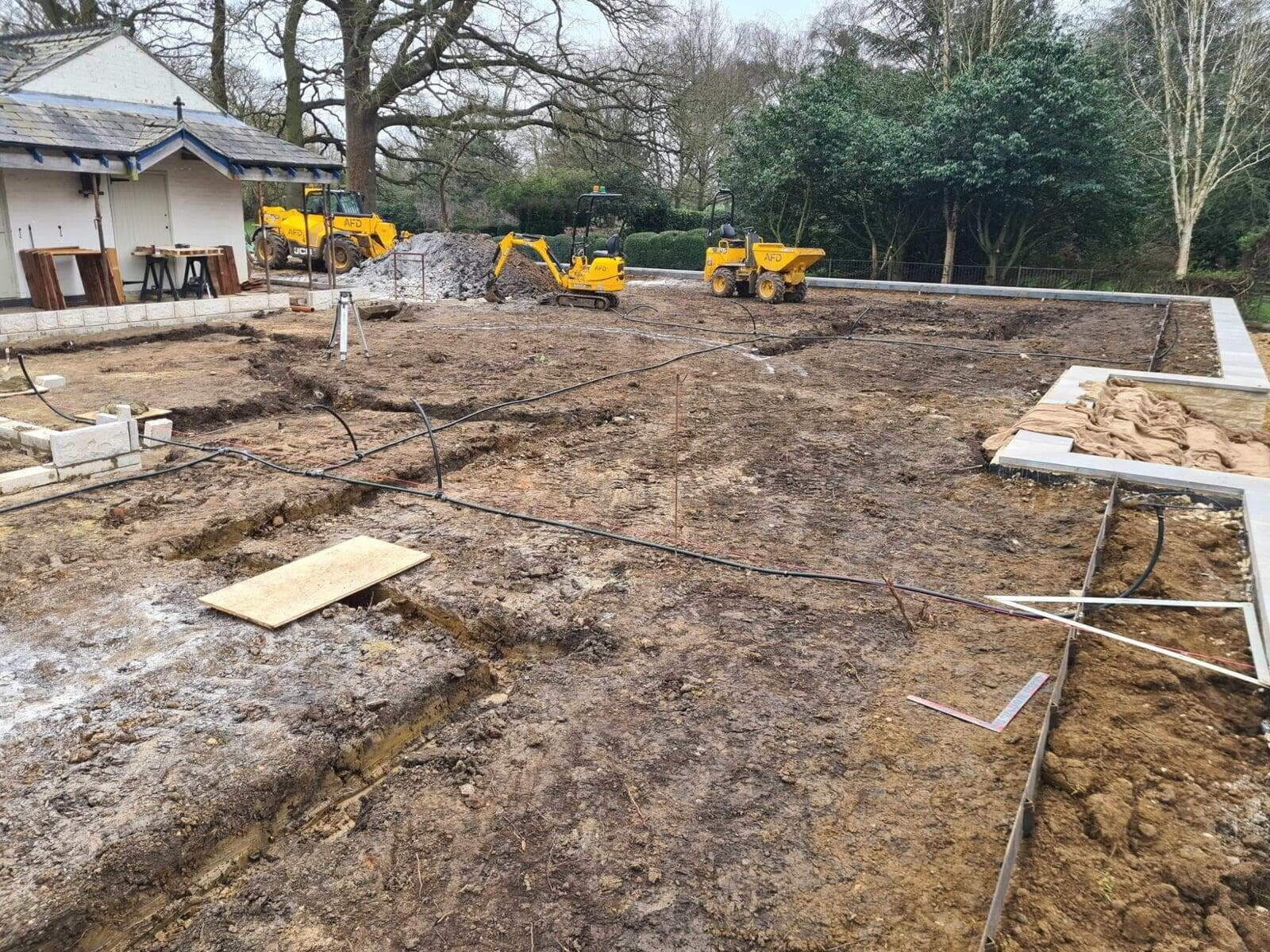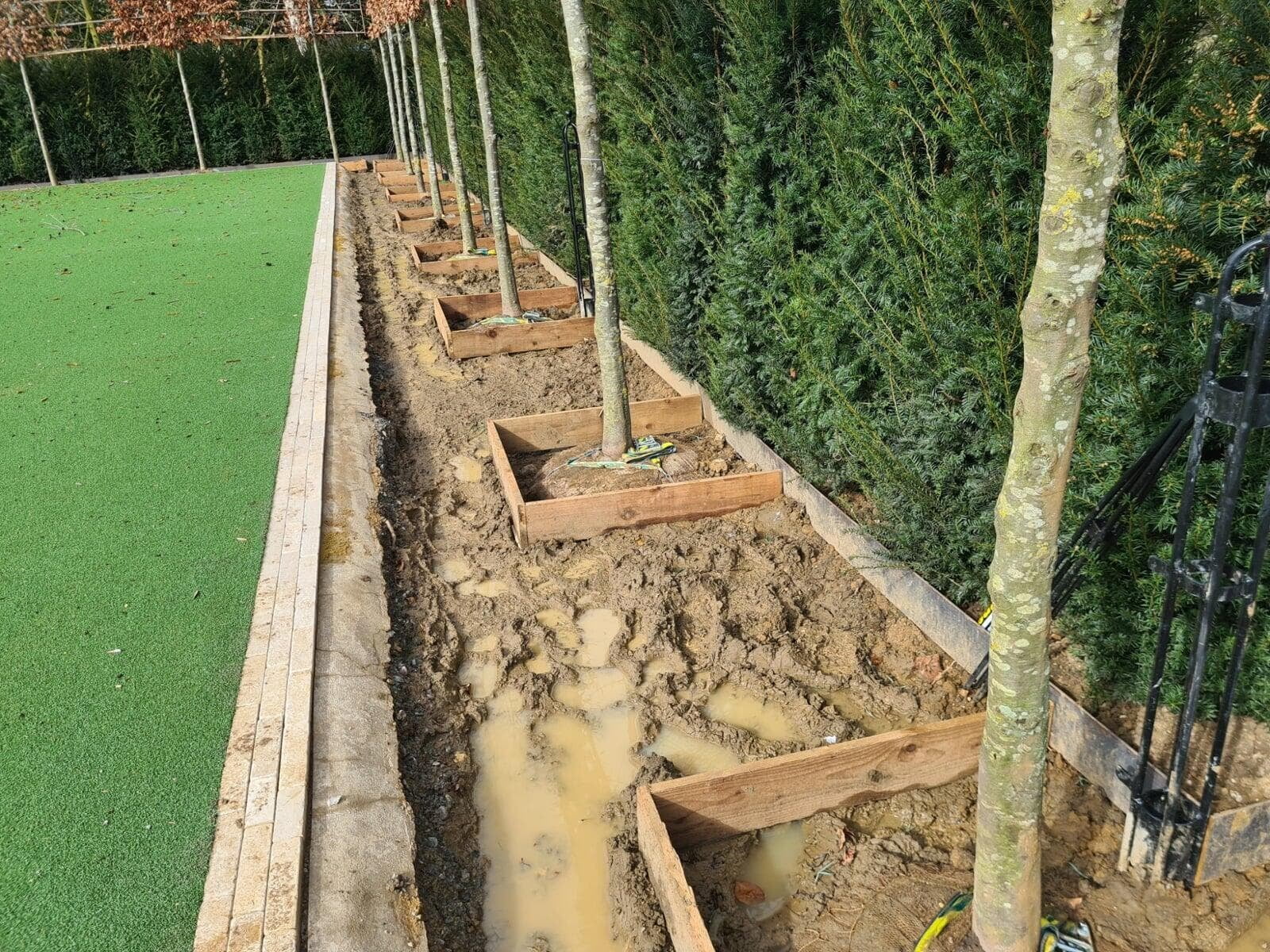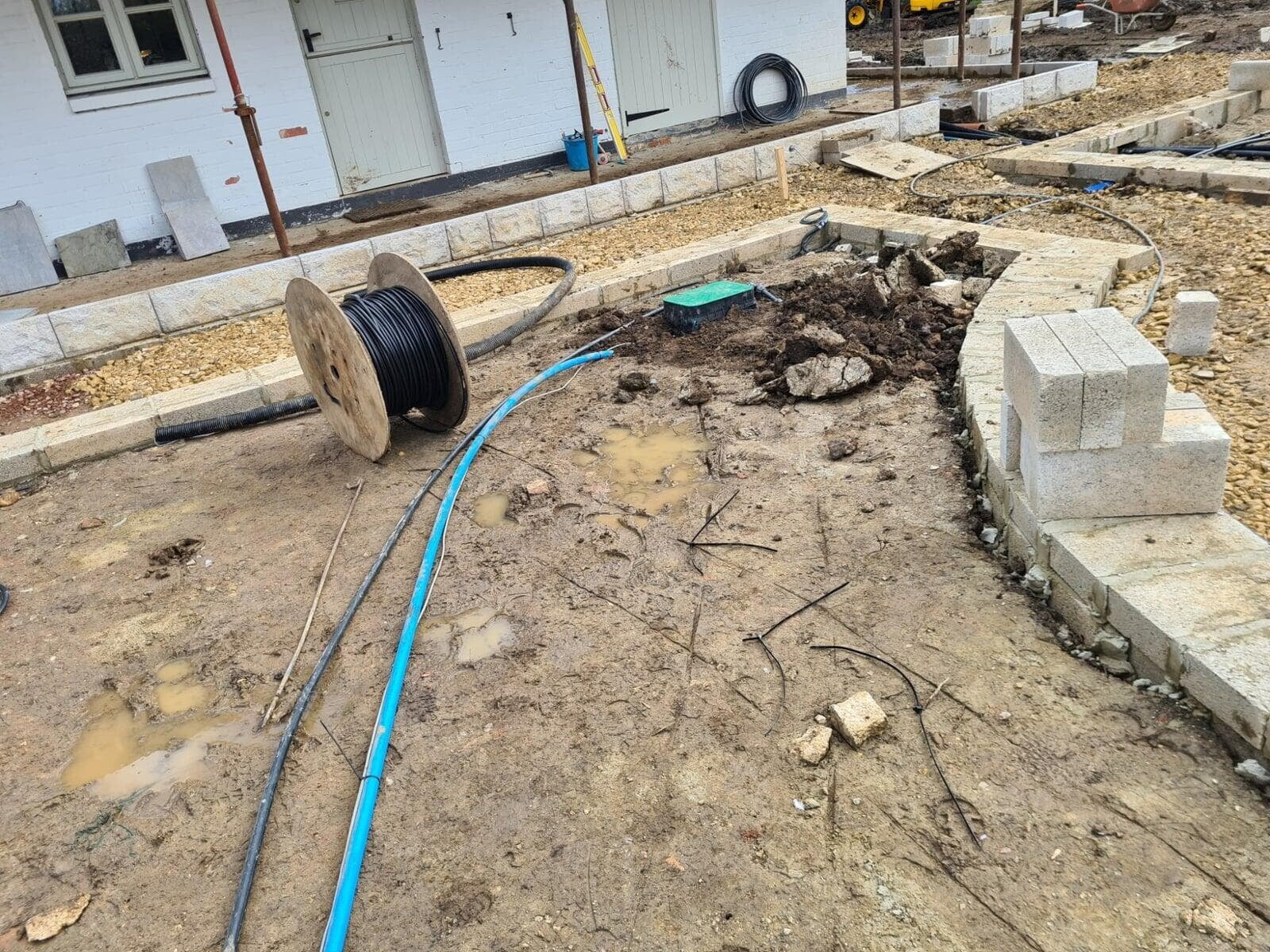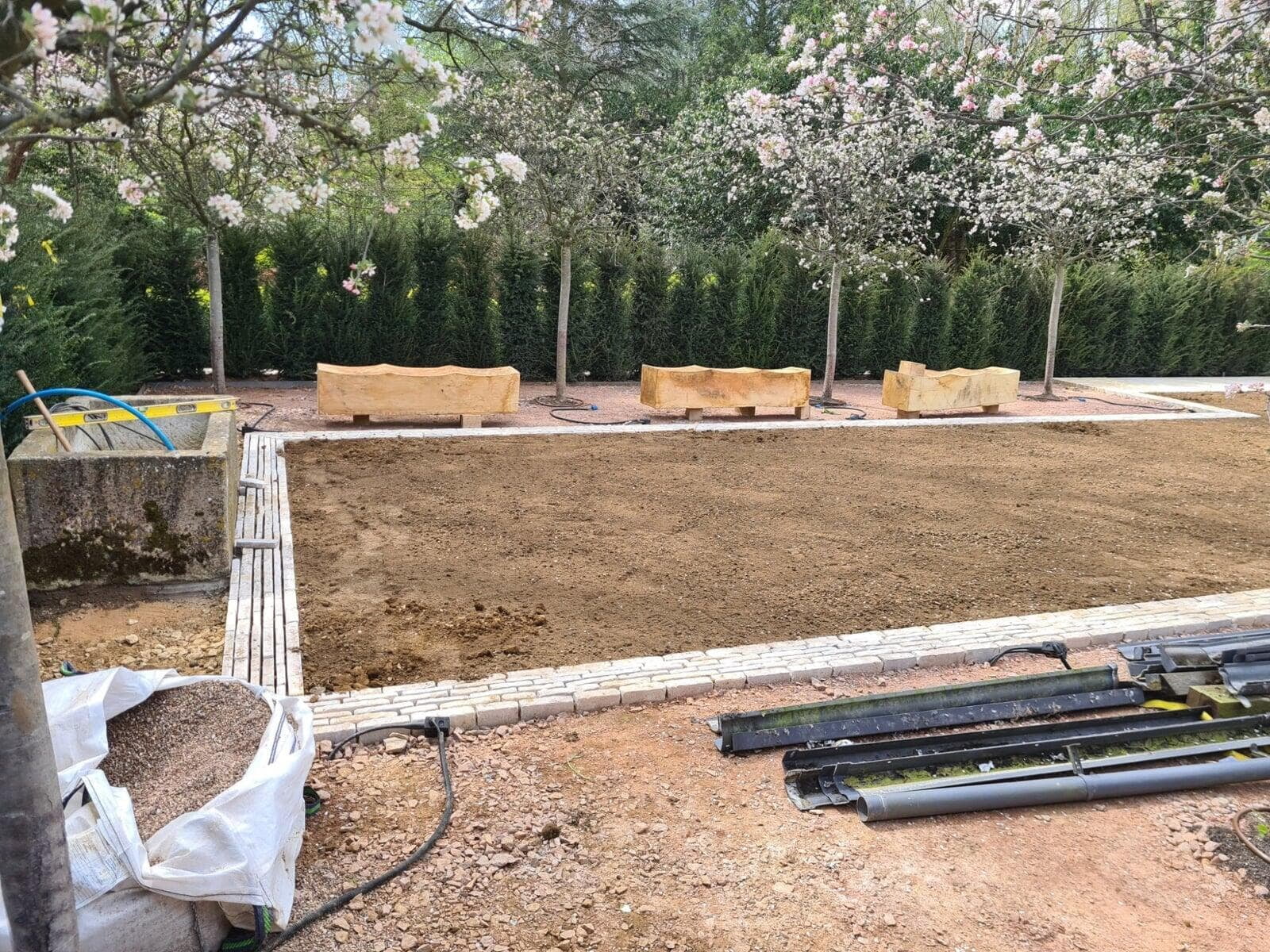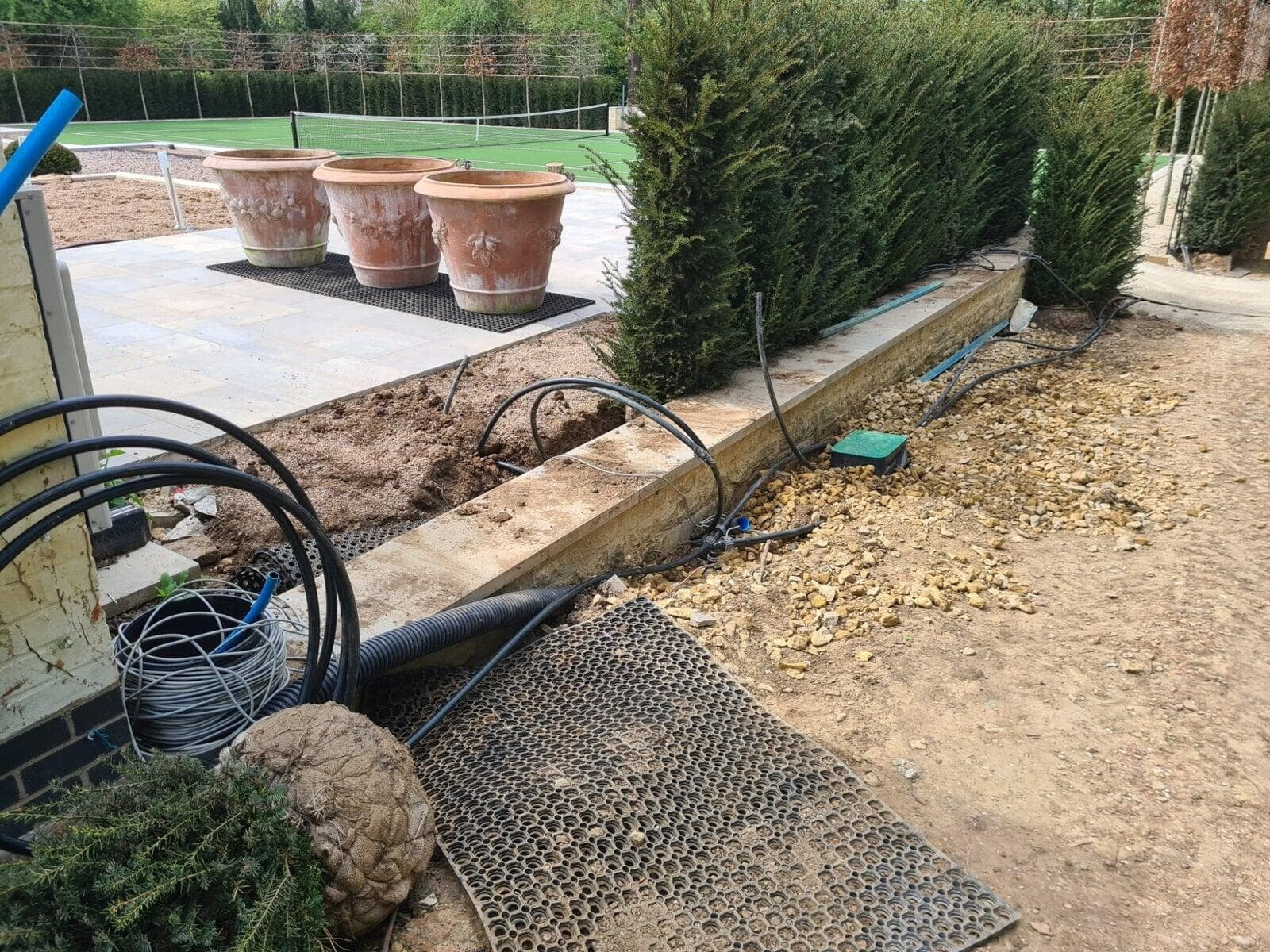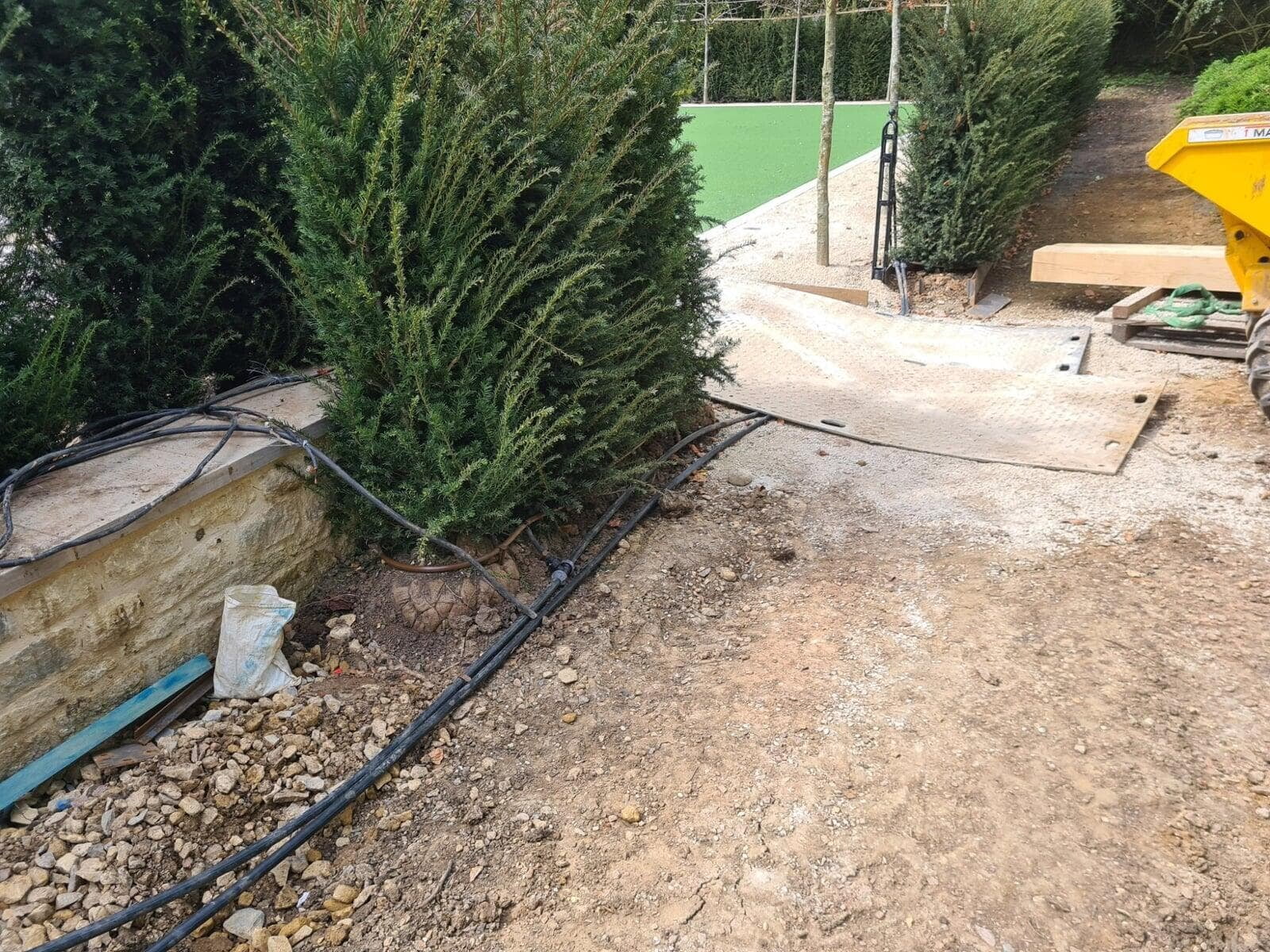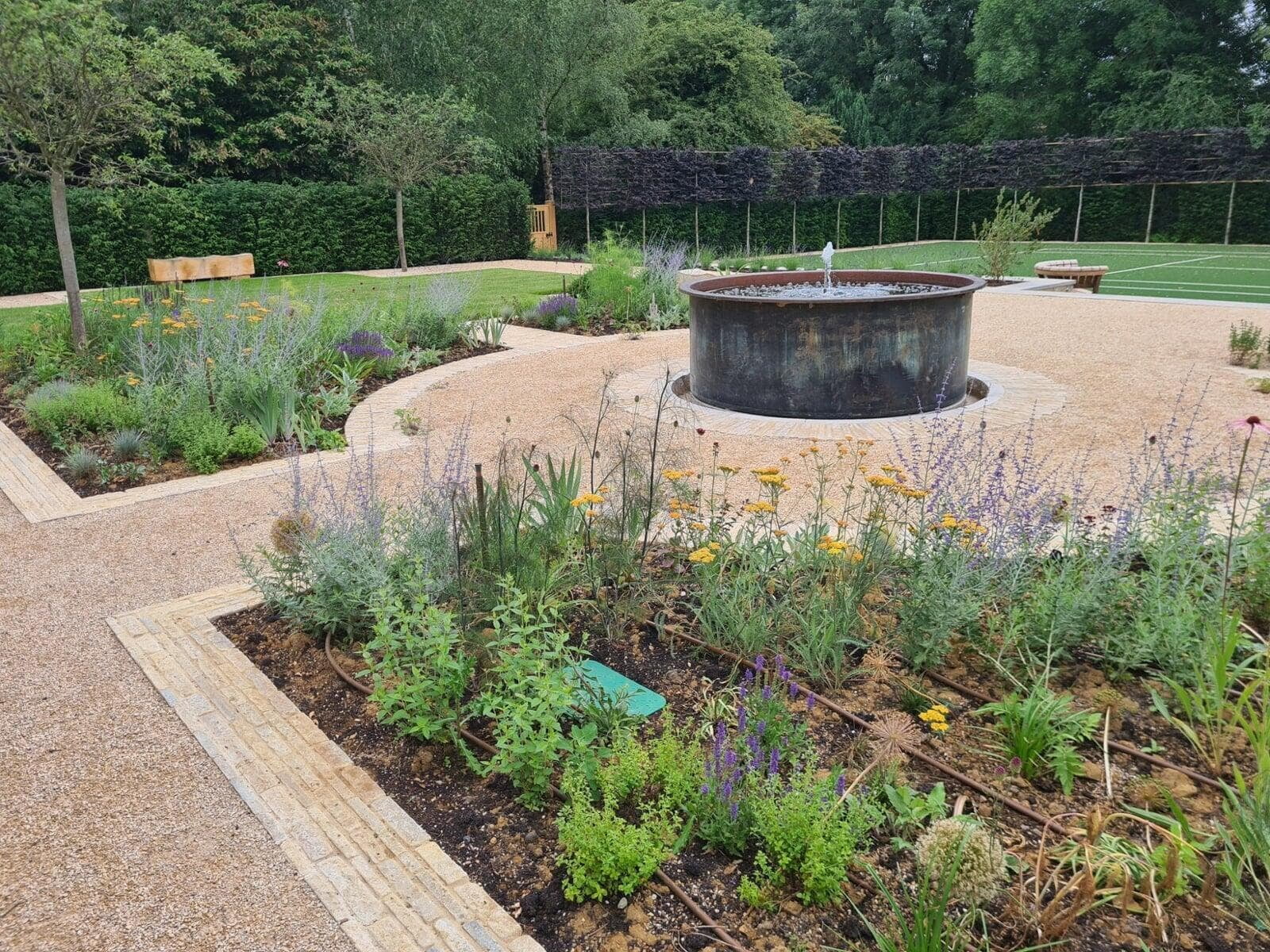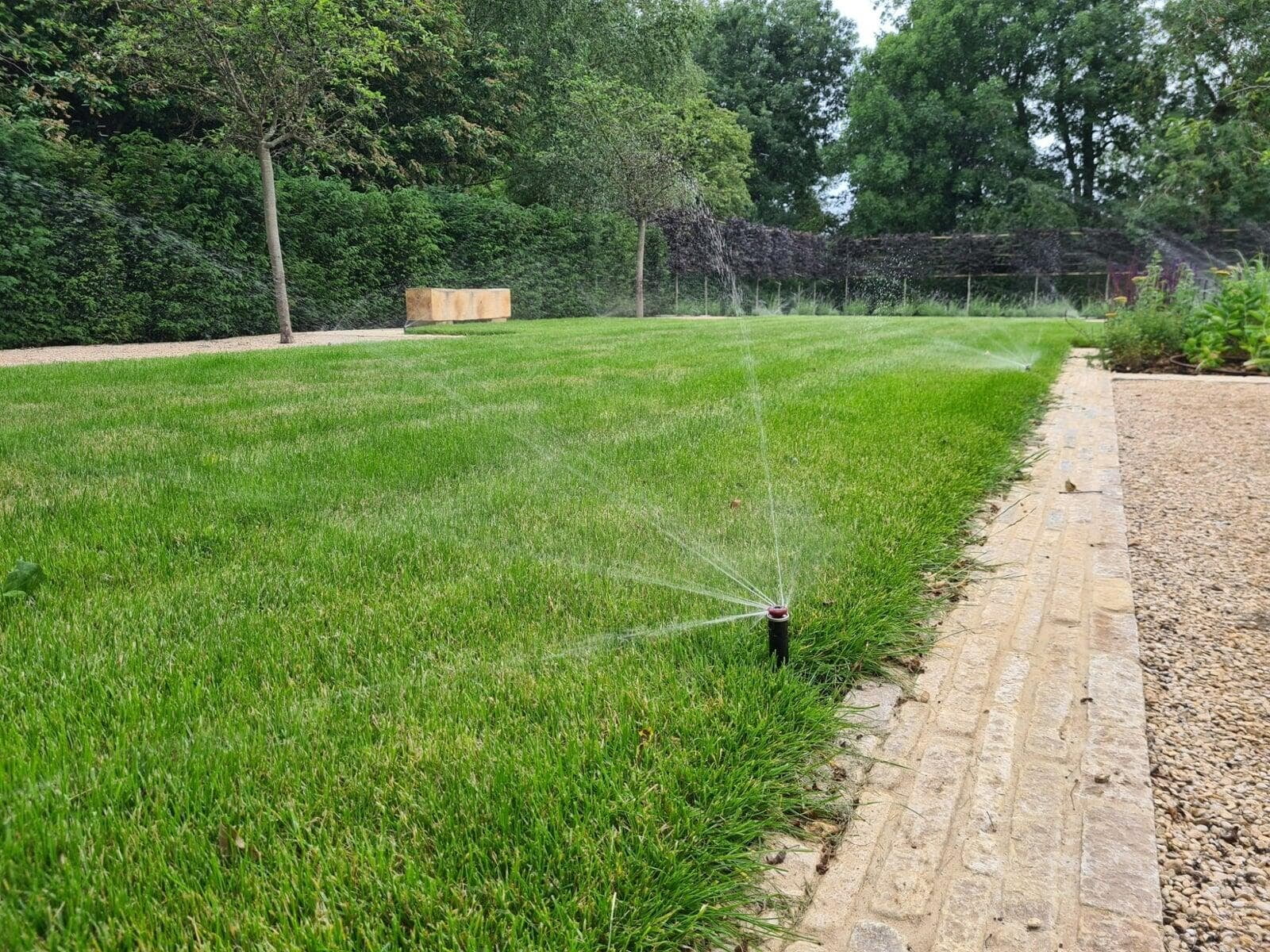Additional Bed Irrigation
Additional Bed Irrigation
The first Layout
This is why the drawing above includes the popup sprinklers and their feeds only, marked with blue circles and different coloured lines.
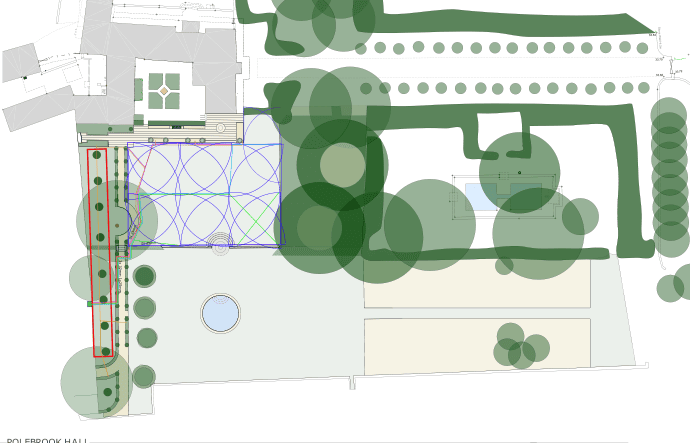
Have a look on the drawing. The the arcs are the edges of sprinkler jet circles.
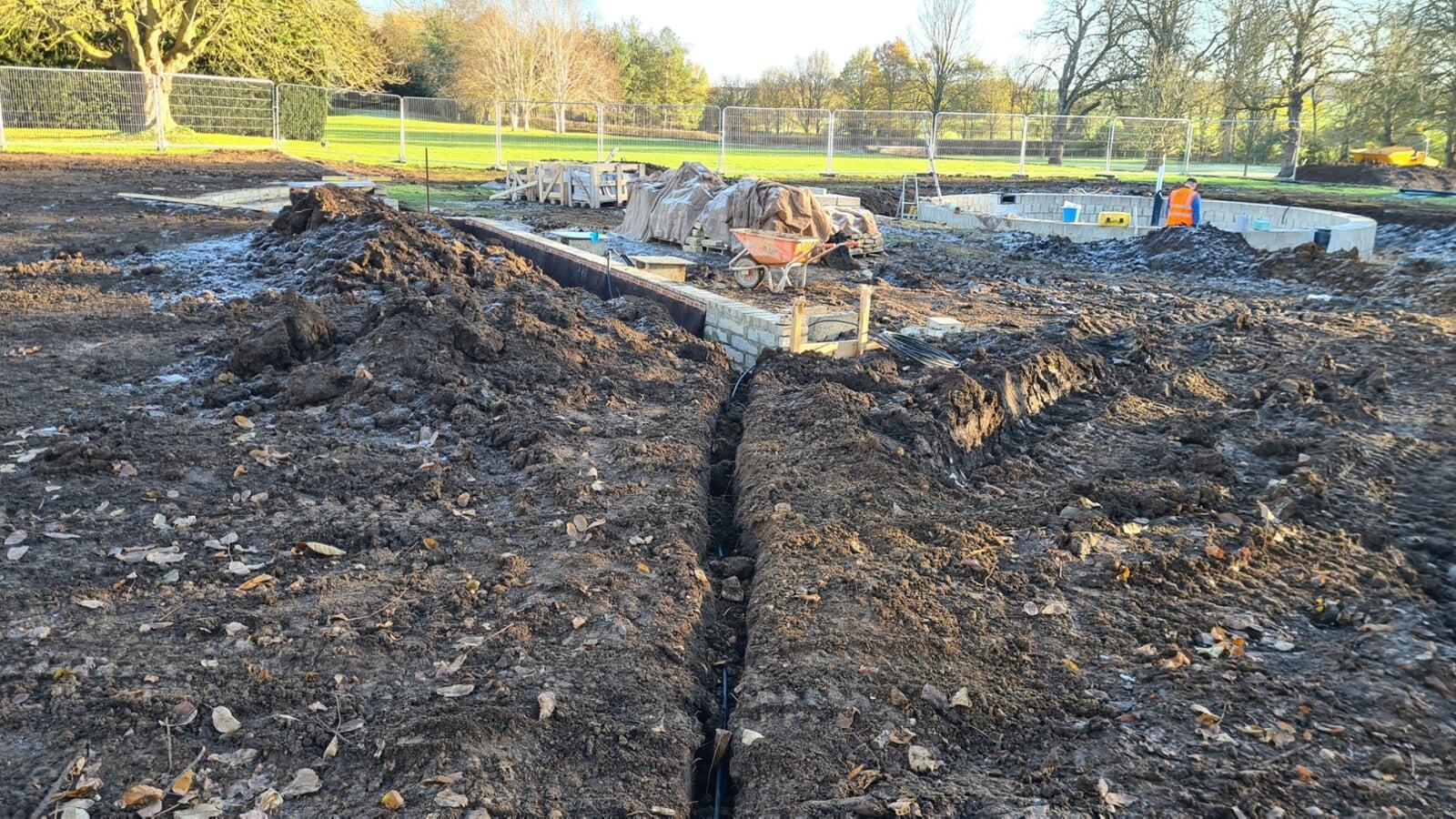
Soilworks
One of our nice narrow trenches leads to the retaining wall on the image above.
The pipe laying jobs were made with our trenching machine in November.
Opening The Trenches
I can’t highlight it enough how nice our trenching machine is.
Thanks to its tracks it sticks to the ground strongly. But if the soil is slippery, then we always can put some extra weight (the handler’s weight) on the machine by folding down its stepping platform.
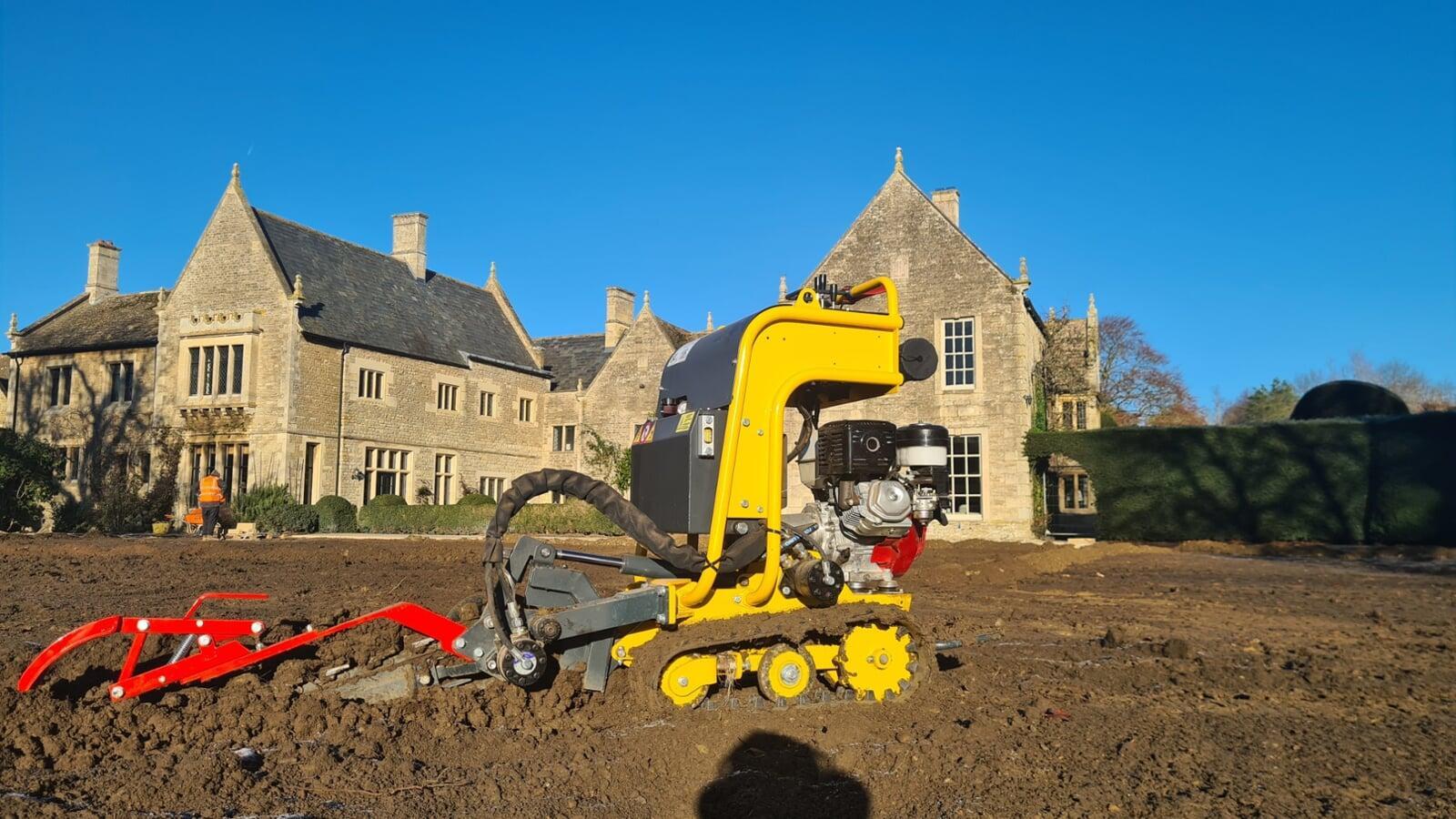
Final Level
But we were in the right place at the right time to install the pipes and heads before preparation of turfing.
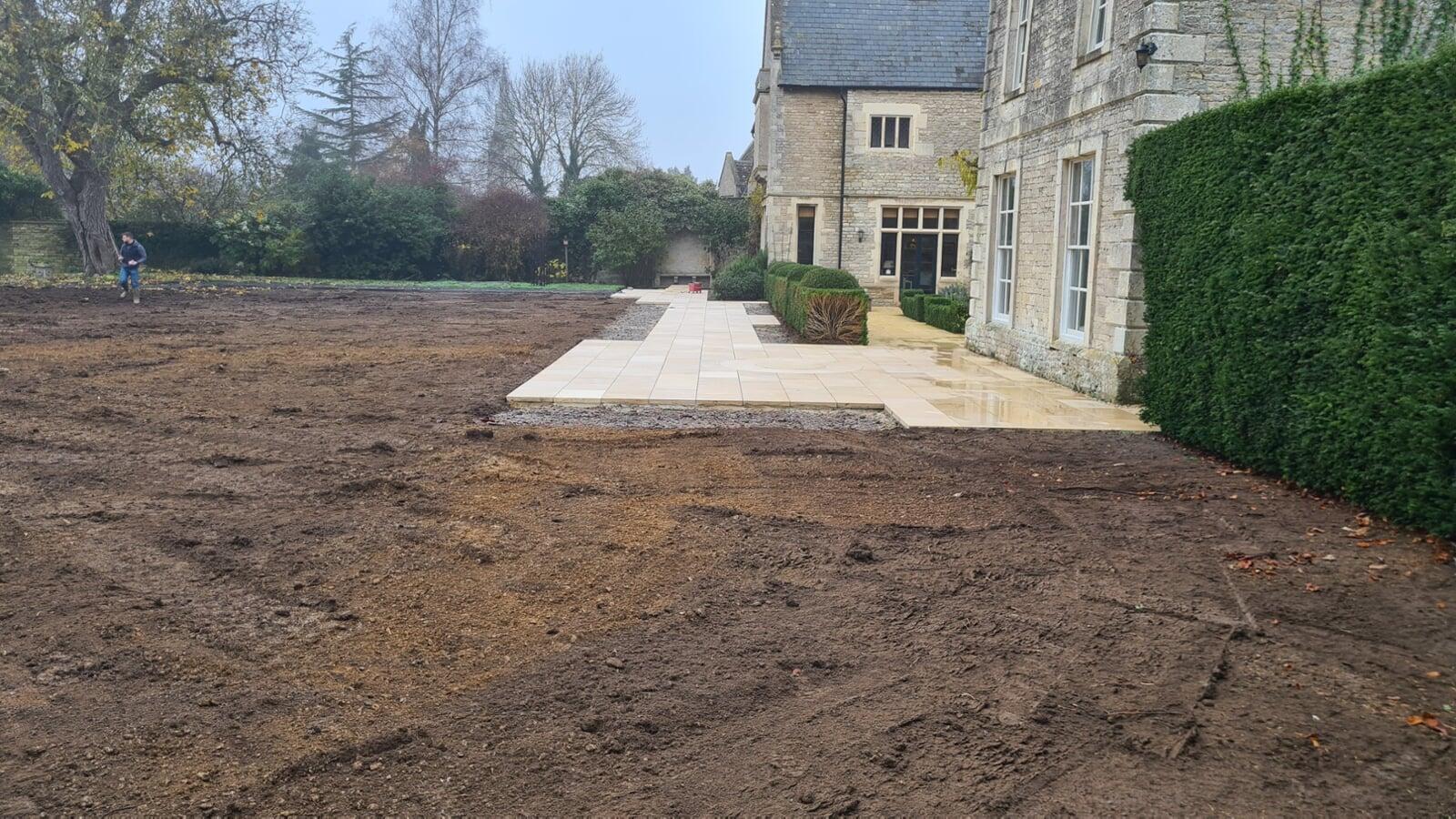
Rough final level made by machines. Fine levelling is a raking job for enthusiast landscapers.
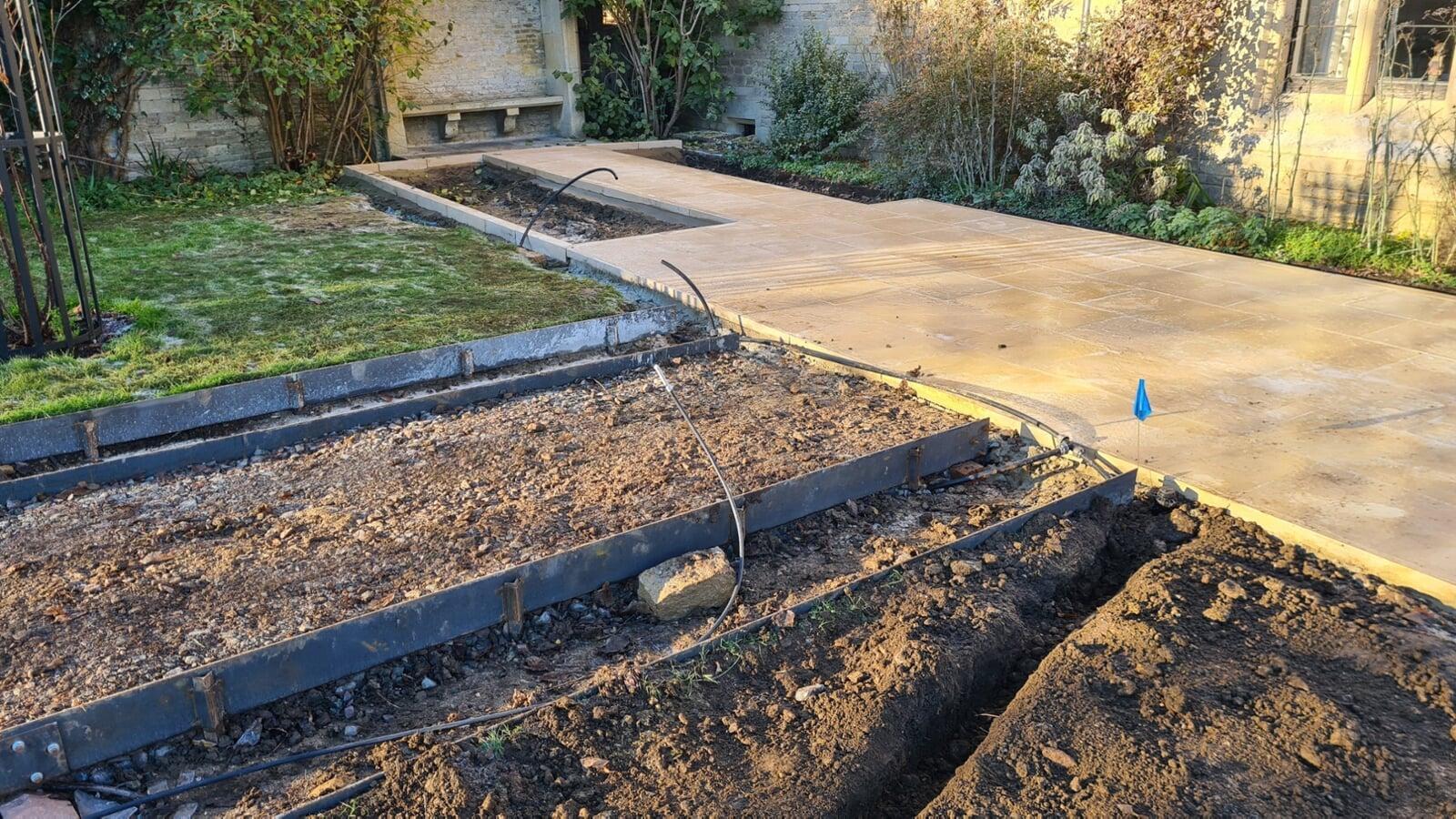
Levelling Sprinklers
Popup sprinklers are invisible most of the time unless they are not levelled perfectly.
At this job, the sprinklers have been installed before the turfing as it happens most of the time. We used to mark them with small flags so the landscapers won’t ruin them by accident.
Best time for levelling when the turf just been laid. The top of the popup must be half-one inch deeper than the final surface. This makes sure that the lawnmowers/robot mowers can’t cut them.
Main Lawn Finished
Hunter PGP Ultra one-jet rotor sprinklers are in place with blue nozzles, 11 m from each other.
The sprinklers do their jobs and so do the dogs. Hence the lawn is “boosted” in patches by ammonium.
You can find more after job pics in the photo gallery.
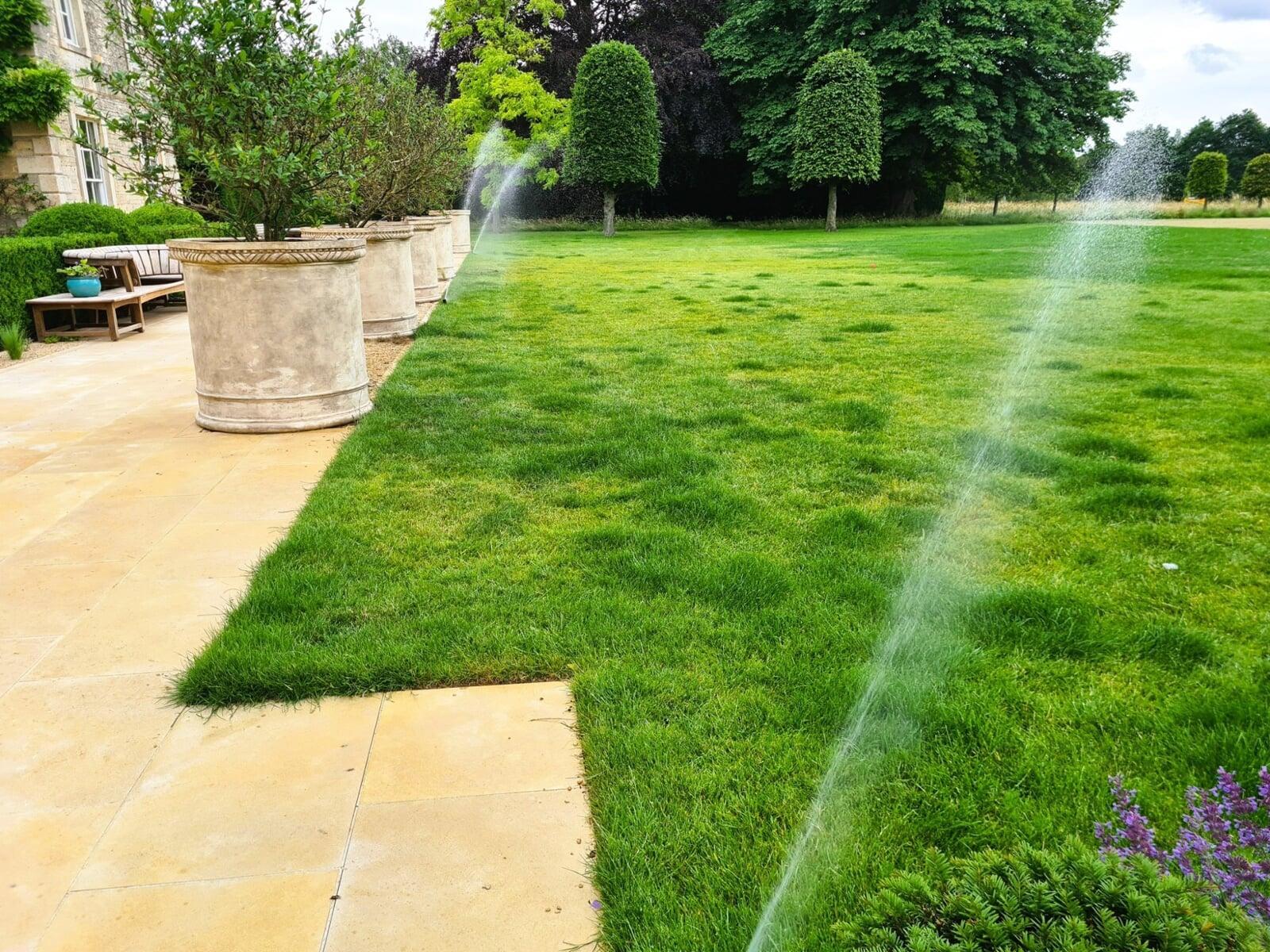
Irrigation For Planters
Preparation For Planter Irrigation
Unfortunately the patio has been done when we were enquired making the yard garden on the left side completely unaccessible for irrigation pipes.
The only area that we could connect to the system here was the row of planters designed over the shingle strip.
The feed pipe runs together with the popup sprinkler feeds along the edge of the lawn and sticking out in the middle of the shingle breaking through the concrete edge of the bed.
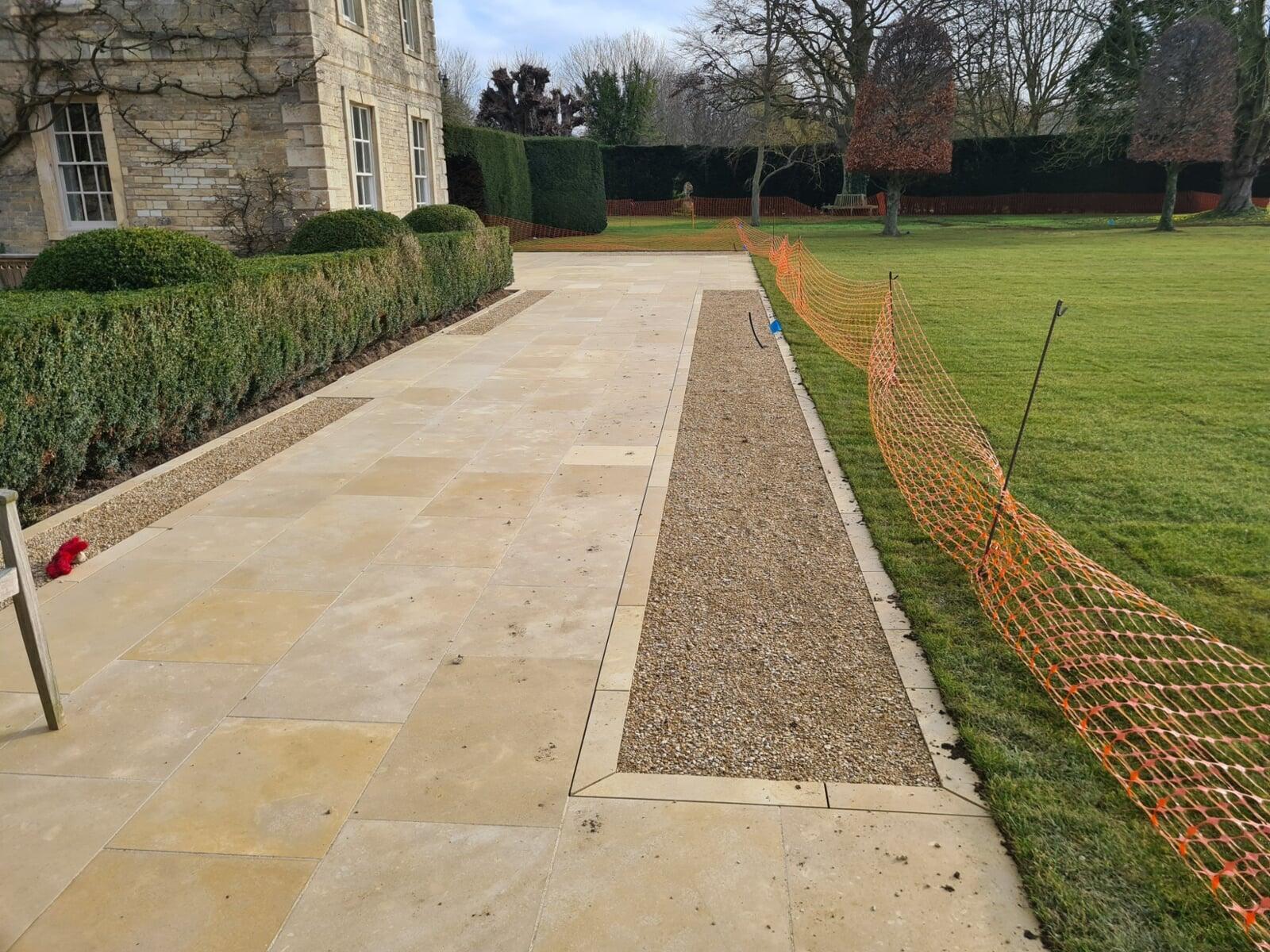
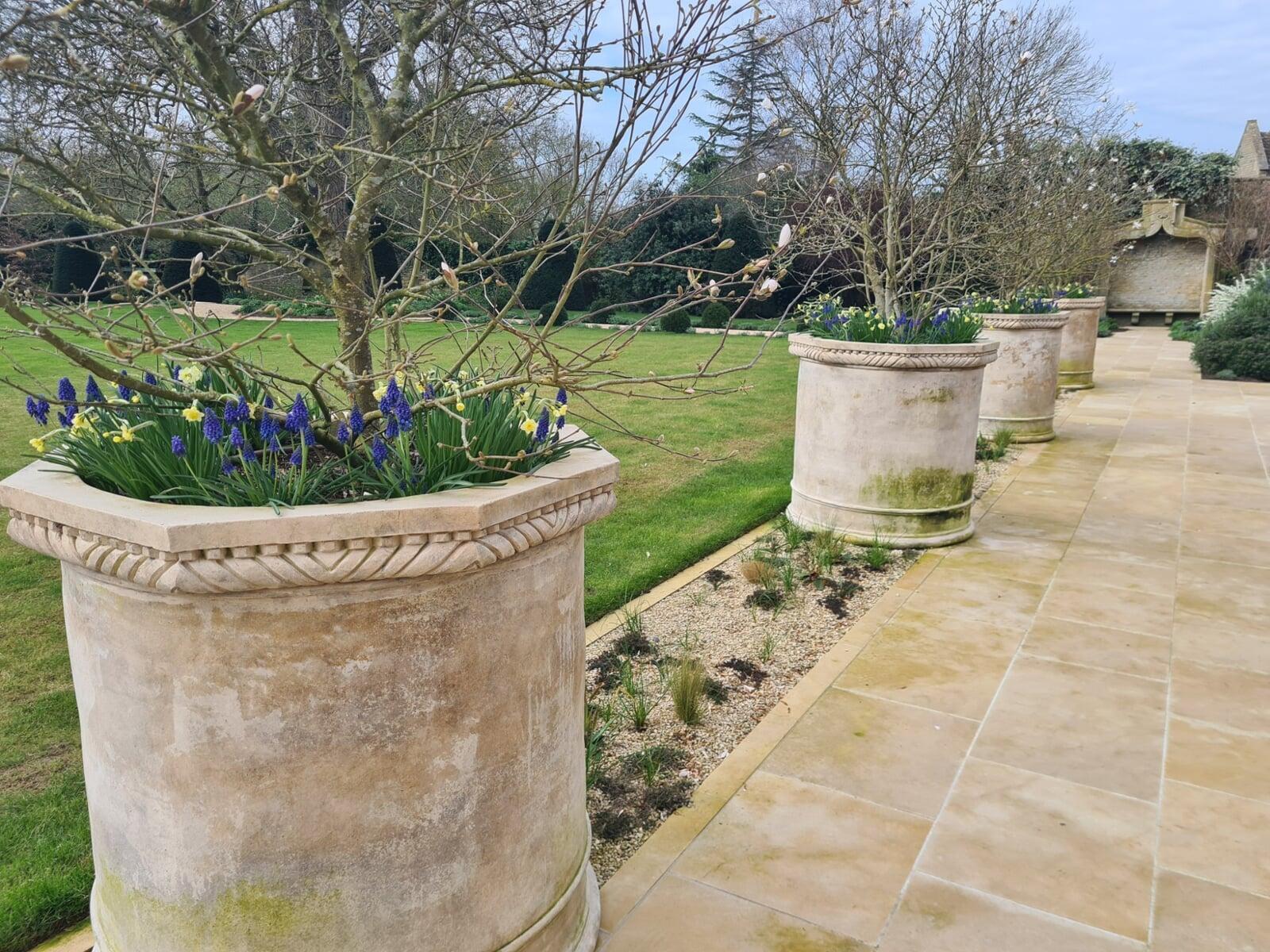
Invisible Feeds
Just before arrival of the planters, we asked the landscapers to mark their exact place and extended the feed right under them.
Our special flexi pipes (called funny pipes as well) have been poked through the bottom hole of the planters before the trees have been planted in.
When the planters are filled, then connecting the dripline and making a loop on the surface of the soil is a piece of cake. Effective and invisible.
You can edit text on your website by double clicking on a text box on your website. Alternatively, when you select a text box a settings menu will appear. your website by double clicking on a text box on your website. Alternatively, when you select a text box
For installing the system invisibly, the pipes should arrive right under the planters and have to be poken through the drain hole of the planters. So the accurate location of the planters has to be marked before the pipes are laid.
Additional Bed Irrigation
Additional Bed Irrigation
base of the path
The edges are perfectly straightforward hence no chance to make a mistake by leaving the feed tail in a wrong place.
Dripline doesn’t need high pressure for operating so we used 20mm HDPE pipe as feed.
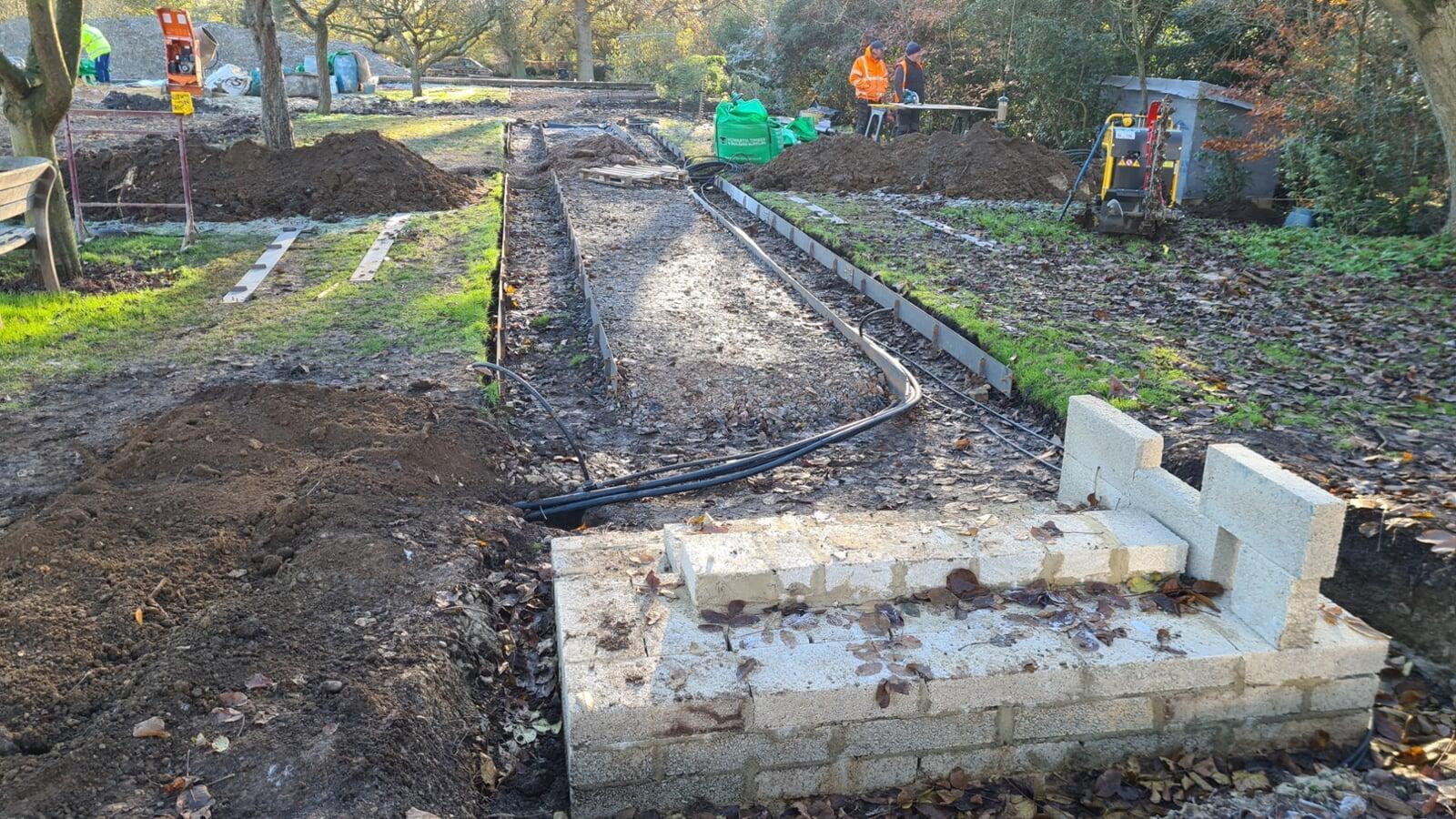
You can discover our trenching machine on the right side of the image.
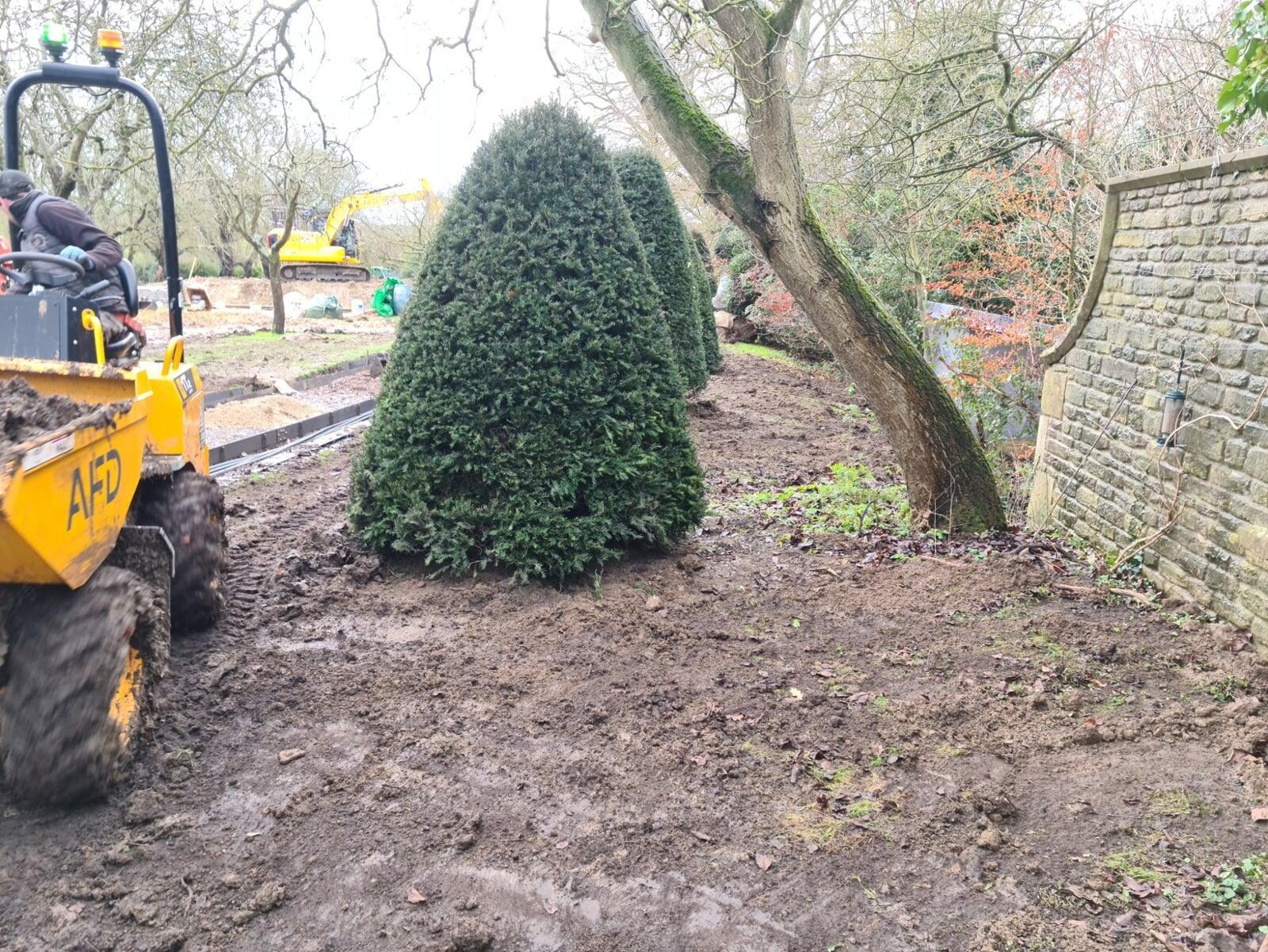
Thirsty Large Solitaires
Nine giant yews have been planted on this site.
This size of plants are delivered with relatively small root balls. Hence they demand lots of water in the first-sceond summer season which can be delivered by an automatic irrigation system reliably.
Compared to the price of a long row of these expensive plants, the irrigation system is a small addition.
FLower Beds In Preparation
Half of the left hand side of the path is planned to be planted finally. It means a newer extension to the originally designed dripline: actually five-times bigger area will be covered.
Luckily the system has been oversized both on boosting and feed sides so we said: go ahead.
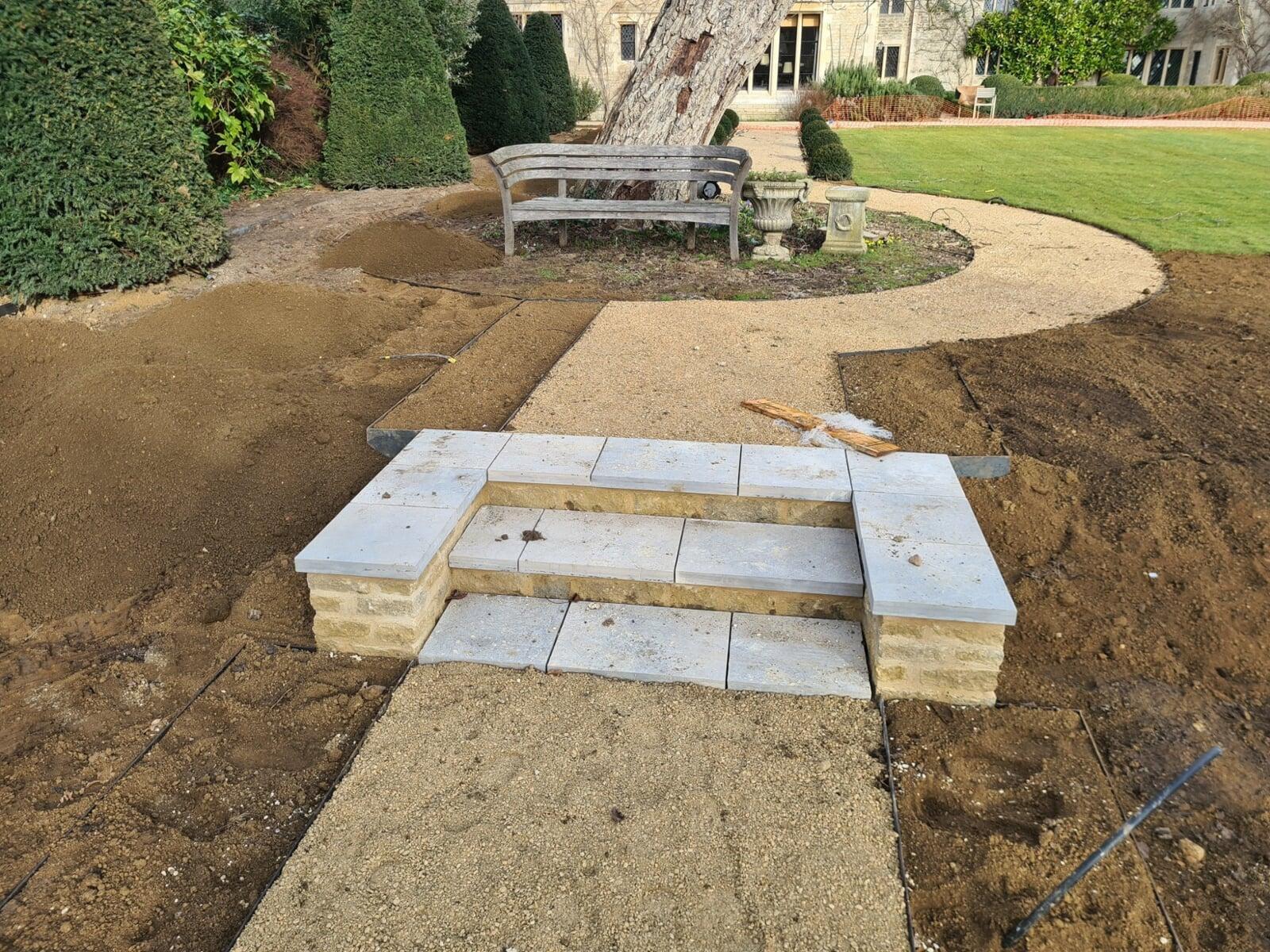
Newer Extension Called Piggery Garden
Newer Extension Called Piggery Garden
- a tennis court surrounded by pleached trees and inpenetrable yew hedge, both with different water demands,
- a rest area with small flowering perennials,
- a barbecue terrace with large planters around,
- small flowering trees,
- and a formal lawn.
- a visitor car park,
- surrounded with pleached tress and hedge.
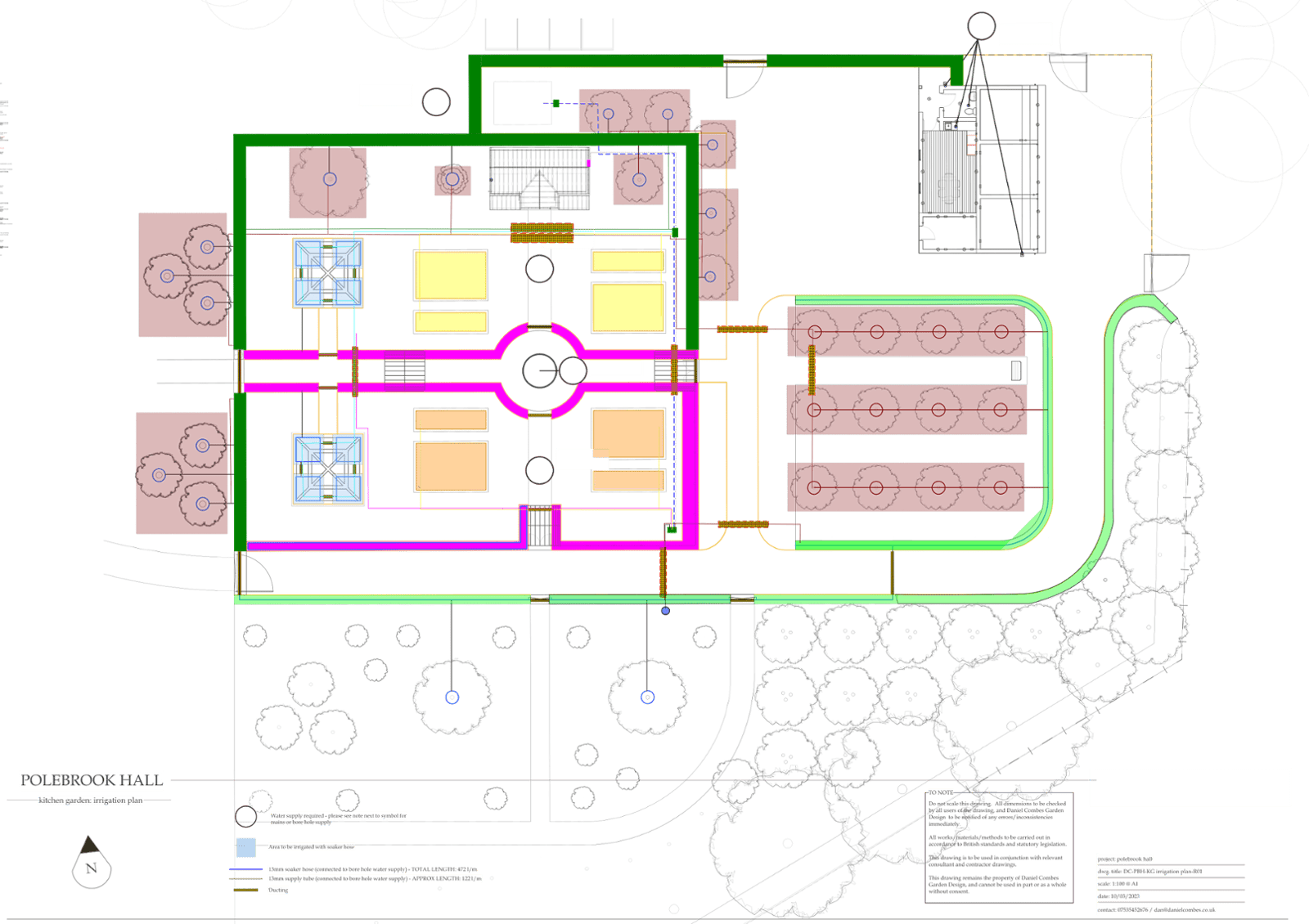
Feed For Dripline
This not just made our jobs easier but the feeds got in the right depth to avoid any later disruption at later gardening soilworks.
Because the feeds have been left there for long time, their open ends have been closed by strong tapes.
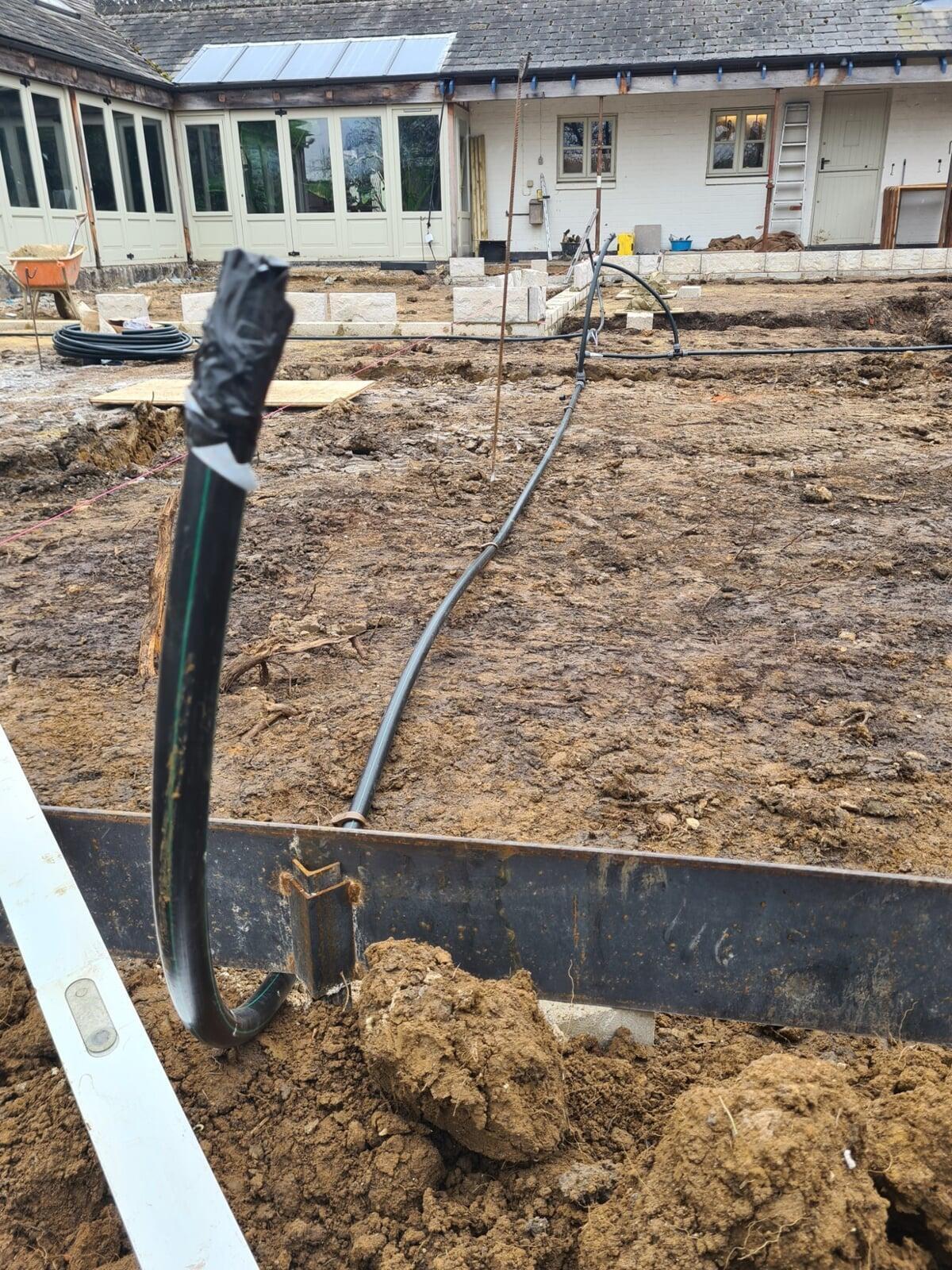
Irirgation drip feed sticking out in one of the beds
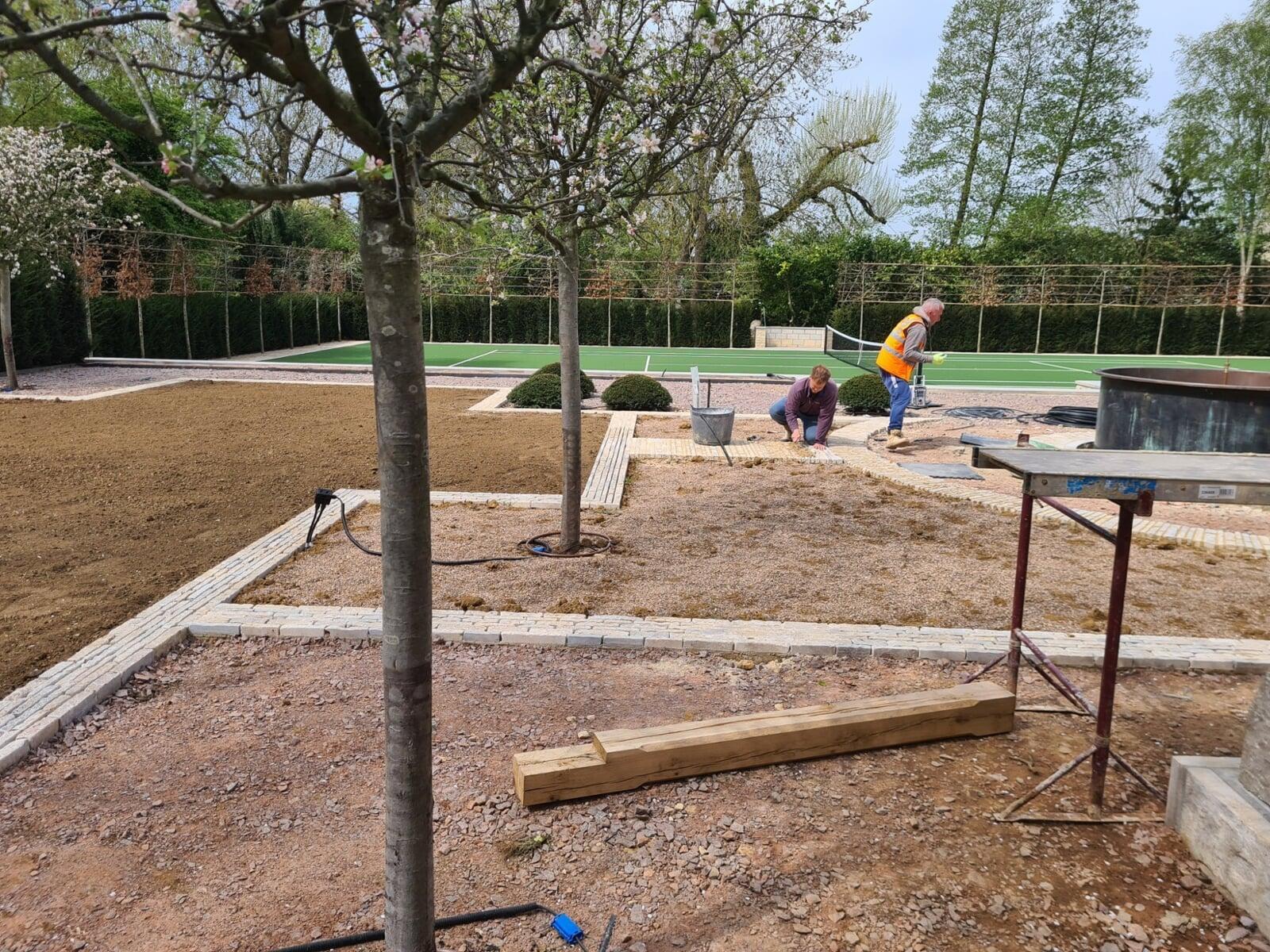
Irrigation for pleached trees VS hedge
Around the tennis court, we installed two separate zones, one for the hedge and one for the treeline. However both of them are in the same location, they have different water demands. It was simply better to split them.
The yew hedge got two lines of drip on their sides. The inserted drip emitters supply even amount of water all along the lines.
And we installed only one feed around the trees and added individually adjustable bubbler to each one of them. This makes possible to supply different amount of water for each tree right at their root ball.
Dripline for wide areas
Dripline is a very efficinet way of watering if the lines are laid as per manufacturer’s recommendation.
Depending on the distance of insterted emitters in the pipe, the lines should be laid same distance form each other. In this case, the emitters distance determines 33cm distance between the pipes for achieving even coverage.
Because the small conifers (bottom of the pic) sit on hard surface that hot in summer, they have their own drip rings around them under the white grindings.
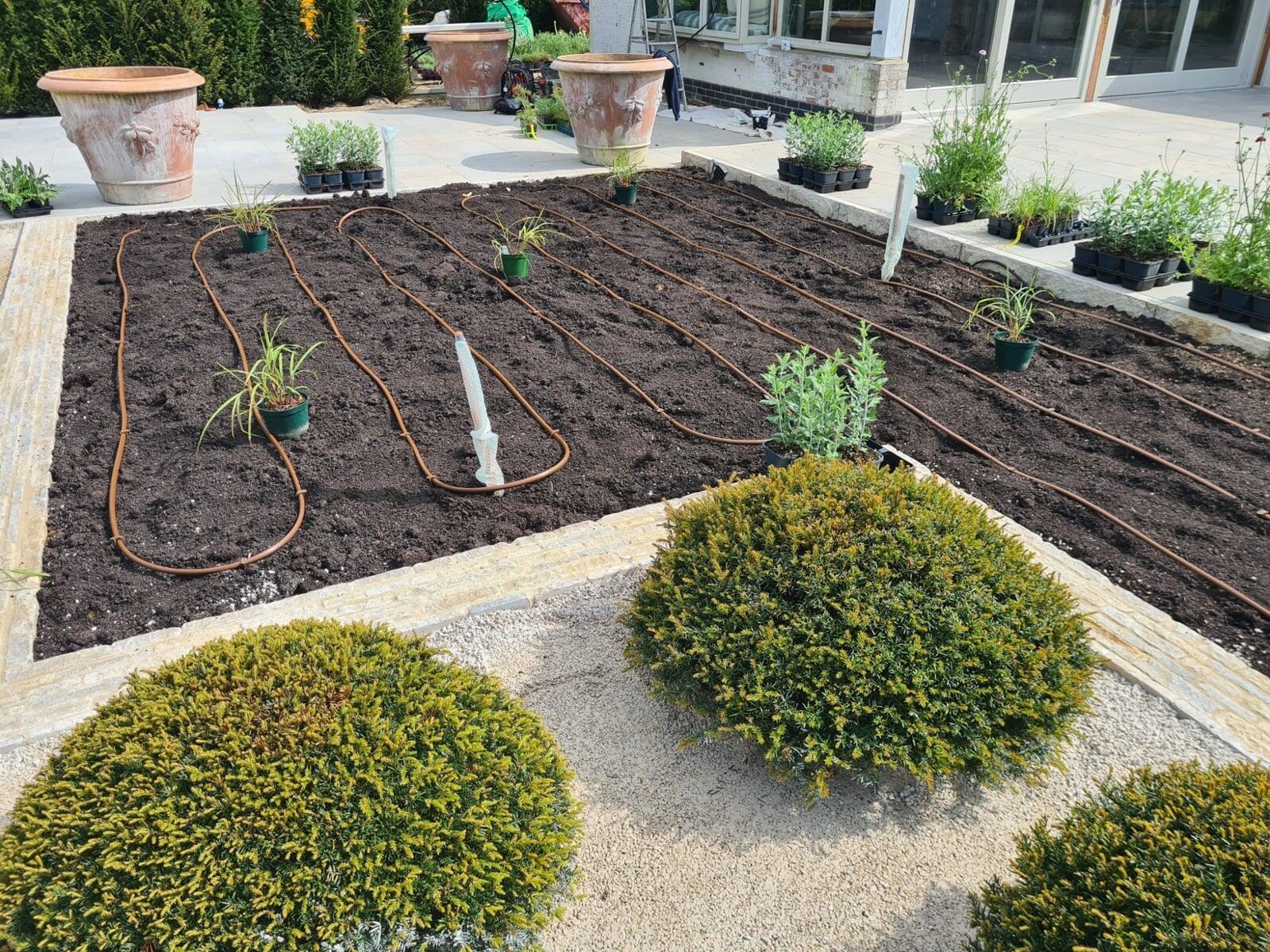
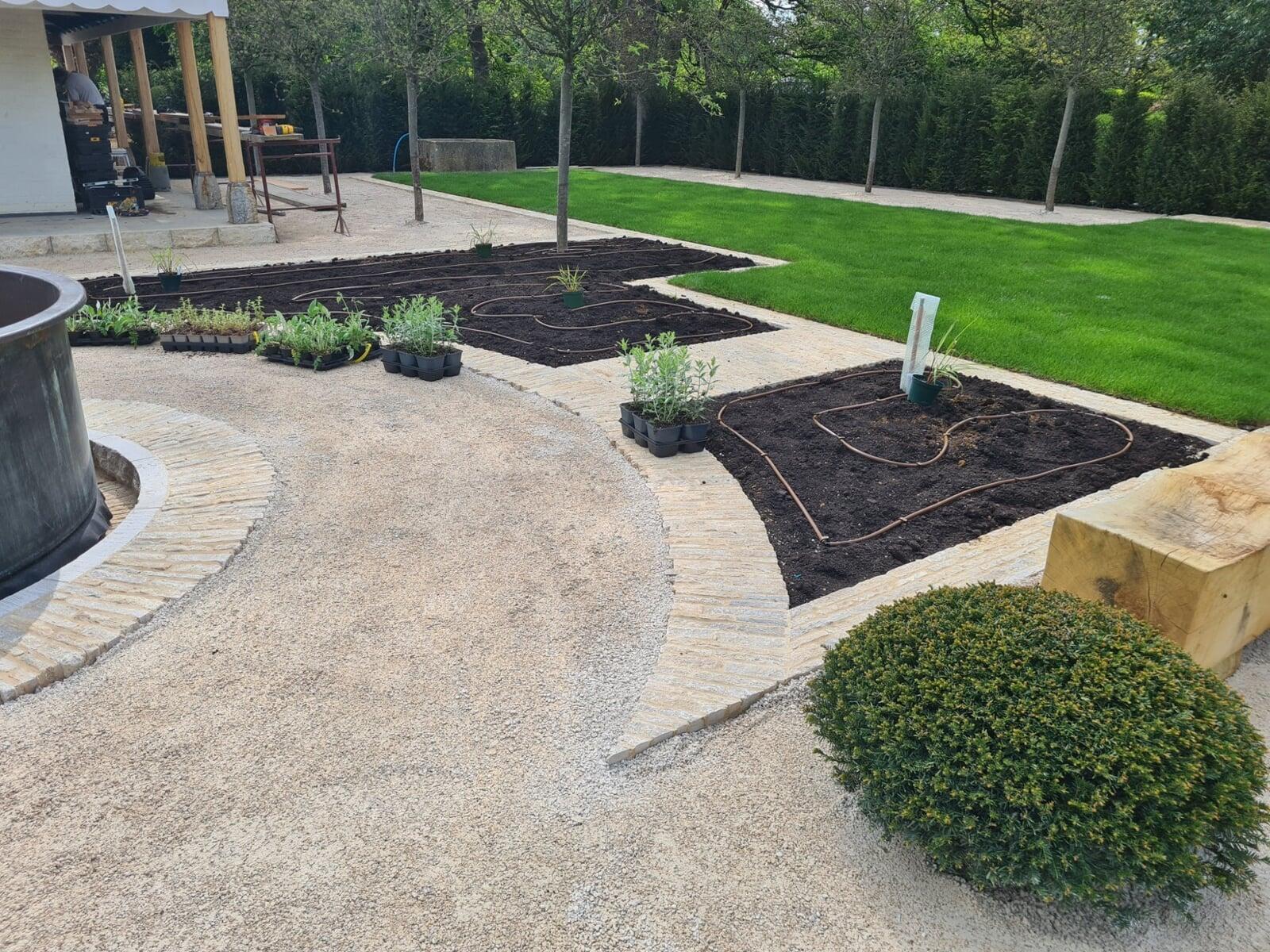
Planting Finished
And this is the final stage at the old piggery garden.
The newly planteed perennials haven’t started to cover the dripline but it will happen soon.
Thanks to this complex irrigation system of that large property near Peterborough, these plants won’t suffer in the heatwave.
Supplying Water
As I mentioned before, the water supply hasn’t even been designed at the first stage but borehole was demanded so we definitely had to go towards a boosted irrigation system.
The usual configuration when the flow of the borehole is unknown is installing a tank and filling it up by the borehole pump. Running out of the water in the middle of an irrigation cycle is avoidable this way.
I don’t have images about the tank as it’s a 10m3 underground tank and were installed when we were not on site. But it’s able to store more than enough water for three irrigation cycles supplying the water for the whole system reliably.
The pump is a premium quality Lowara submersible stainless-steel pump with a DAB pressure switch. When any zone is fired, then the pressure switch is powering up the pump immediately. By using pressure switch, the main feed can even be equipped with garden taps as this is the case on this property as well.
Summary
This large irrigation system was designed and installed together with the constantly changing landscaping process we still managed to keep it in scale. The lawn zones give even coverage thanks to the consistently used nozzles. The drip irrigation zones include similar size and type of plants with almost identical water demands.
Not mentioning the environmental benefits of an automatic irrigation system for large residential properties, like
- Efficient Water Use: Automatic irrigation systems use sensors and timers to deliver the right amount of water at the right time, reducing water wastage compared to manual watering.
- Reduced Runoff: By applying water more precisely, these systems minimize runoff and ensure more water penetrates the soil, benefiting plant roots directly.
- Controlled Watering: By delivering water slowly and evenly, automatic systems reduce the risk of soil erosion that can occur with traditional irrigation methods.
- Weather-Based Adjustments: Many systems use weather data to adjust watering schedules based on current conditions, avoiding unnecessary watering during rainy periods or adjusting for seasonal changes.
- Optimal Watering Schedules: Consistent and adequate watering ensures plants receive the right amount of water, promoting healthier growth and reducing the need for chemical treatments that can harm the environment.
- Efficient Operations: Automatic systems often use less energy than manual systems because they operate more efficiently and can be powered by renewable sources such as solar panels.
- Consistent Moisture Levels: Regular and appropriate watering helps maintain soil structure, reducing compaction and promoting a healthy microbial ecosystem.
- Advanced Technology: Features like drip irrigation and moisture sensors enhance the efficiency of water delivery, ensuring that every drop counts.
- Integration with Smart Technologies: Automatic systems can be integrated with smart technologies and IoT (Internet of Things) devices, allowing for more sustainable management practices and real-time monitoring of water use.
I hope you enjoyed this short introduction of one of our last large residential irrigation system jobs and we have served you with some useful advice regarding automatic garden irrigation. If you want some reasons why you need irrigation system, then read our other articles as well.


